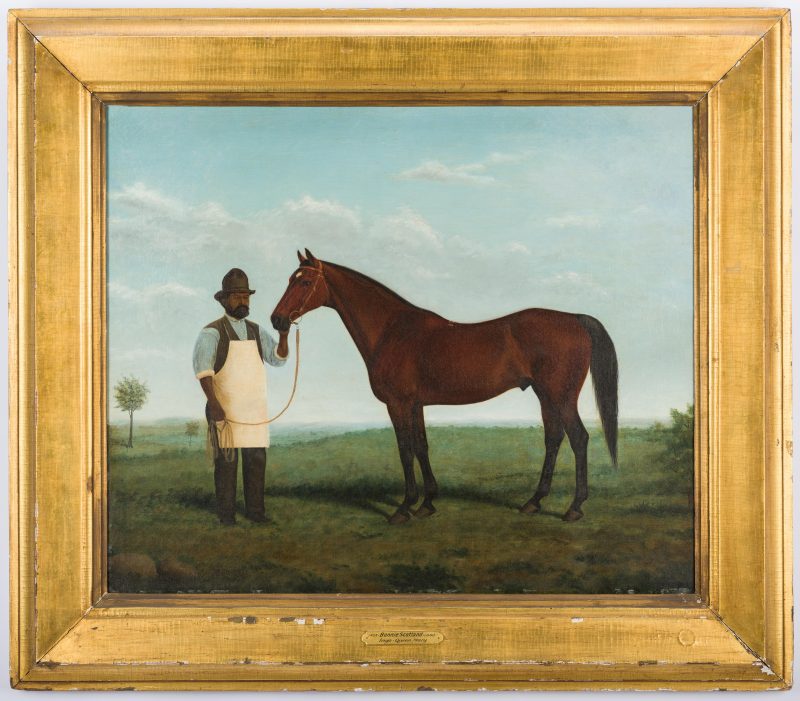 |
|
Herbert S. Kittredge (American, 1853- 1881) oil on canvas portrait depicting groom Robert Green with Belle Meade Plantation’s premiere stallion, Bonnie Scotland, 1879. This is the only known lifetime oil portrait of Bonnie Scotland – a horse through which every winner of the Kentucky Derby since 1960 can trace its bloodline. He was foaled in 1853 in England by Iago – Queen Mary by Gladiator, and originally owned by William l’Anson. Bonnie Scotland overcame an injury at age 2 and went on to win the Liverpool St. Leger, but was injured again while winning the Doncaster Stakes, and retired to stud at the age of 3. He was imported to New York in 1857 and stood at farms including John Reeber’s Fashion Stud in Lancaster, Ohio, and W.F. Harper’s Nantura farm in Woodford, Kentucky. Although the Civil War disrupted the sport of racing in America, Bonnie Scotland spent the early 1860s siring successful runners including Dangerous, Malcolm, Bourbon Belle, and Frogtown. In 1872, General William Harding brought Bonnie Scotland to Belle Meade, where the stallion was bred with higher quality mares, and established one of the most important sire lines in America. According to American Classic Pedigrees, he was the leading sire in America (1880 and 1882, runner up in 1868 and 1871). Clio Hogan’s Index to Stakes Winners 1865-1967 credits him with 21 stakes winners. Some of the famous horses from his line include Bramble, Man-O-War, Sea Biscuit, War Admiral, Secretariat, Seattle Slew, Affirmed, and more recently, California Chrome. Bonnie Scotland died at Belle Meade in 1880, having helped build its reputation as one of the great thoroughbred horse breeding nurseries in the world. Robert (Bob) Green was in charge of all the thoroughbreds at Belle Meade, a position which earned him international recognition. Born a slave, he was brought to Belle Meade in 1839. Thanks to his skill with horses, he soon became General Harding’s right hand man, with four grooms working under his supervision. Green is credited with saving several horses from injury during an ill-fated railroad trip to New York, which was jeopardized by the Johnstown Flood of 1889. Following emancipation, Green became Belle Meade’s highest paid employee, declining an offer from Fairview Farm to stay on with the Hardings. Provenance: descended in the Harding Family of Belle Meade. Sight: 24 1/2″H x 29″W. Framed: 37″ H x 41″W. |
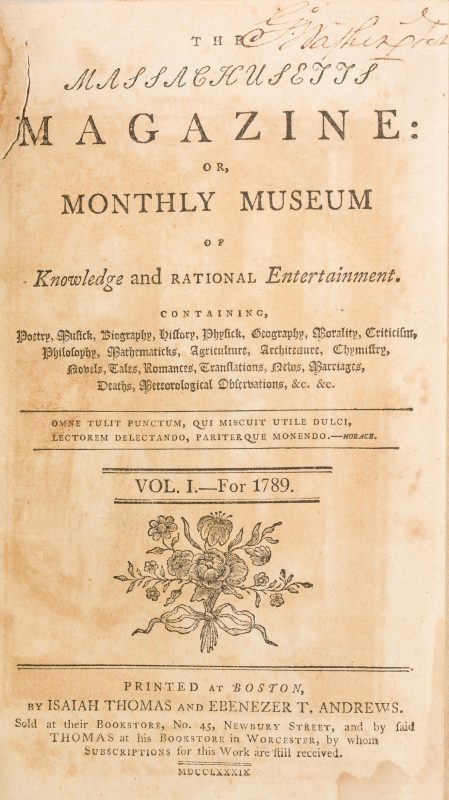 |
|
George Washington signed book from his library at Mount Vernon. Titled “The Massachusetts Magazine: or Monthly Museum of Knowledge and Rational Entertainment”, Volume I, published by Isaiah Thomas and Ebenezer T. Andrews, Boston, 1789. Inner cover bearing Washington’s armorial bookplate, title page bearing Washington’s signature, upper right corner. Octavo, leather cover. Provenance: personal library of Chief Justice John Marshall. More information in the coming weeks. |
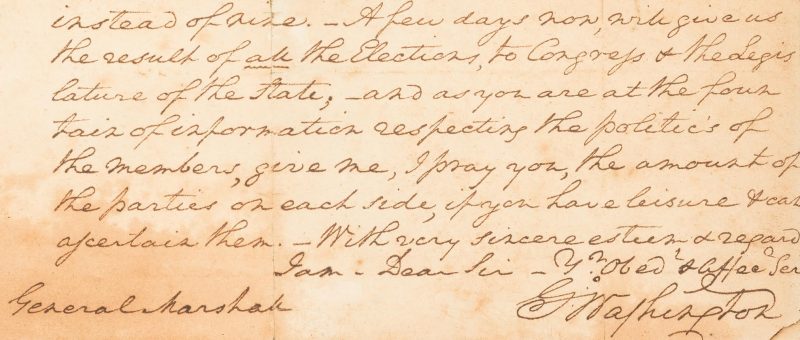 |
|
Handwritten letter by George Washington, Mount Vernon, VA, to General John Marshall (1755-1835), 4th Chief Justice of the United States, Richmond, VA, dated May 5, 1799. Speaking mostly of Marshall’s recent election as a Member of the U.S. House of Representatives, Virginia’s 13th district. Letter – 9 3/4″ H x 16 1/4″ W. Board – 10″ H x 16 1/4″ W. More information in the coming weeks. |
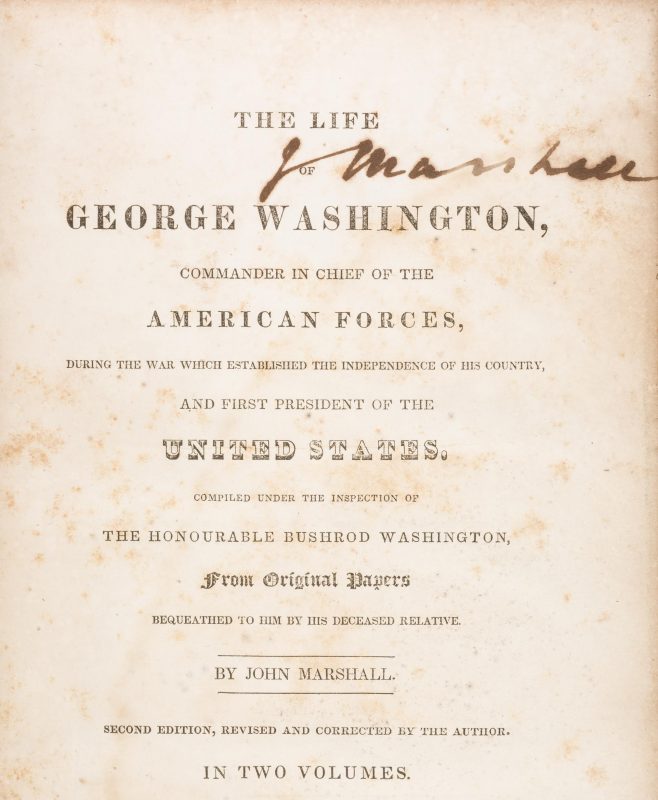 |
|
Signed two volume set of “The Life of George Washington”, by John Marshall, second edition, Revised & Corrected by the Author. First volume with personal inscription by John Marshall to his son James Keith Marshall reading: “For Mr. James K. Marshall from his affectionate father. The Author”. Second volume signed on title page, “J. Marshall”. More information in the coming weeks. |
 |
|
North Carolina Moravian tall case clock, cherry primary, yellow pine secondary. Descended through the Willingham family. More information in the coming weeks. |
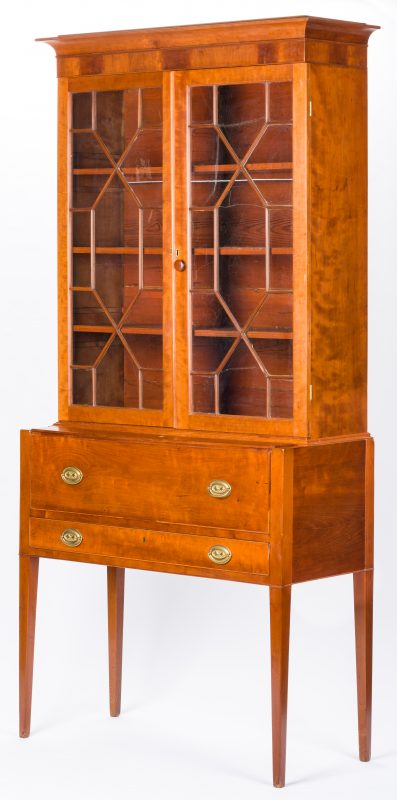 |
|
East Tennessee cherry desk and bookcase, possibly Jefferson Co., TN. Yellow pine, poplar, and white pine secondary woods. Provenance: Overall estate, Greene Co., TN. |
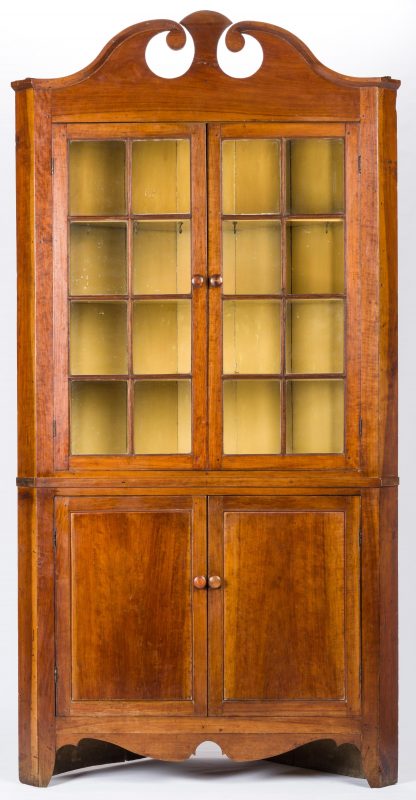 |
|
Greene County, Tennessee cherry corner cupboard, one piece consisting of a broken arch pediment with central plinth fan, canted returns, sixteen pane doors opening to three interior shelves, medial ogee molding over two paneled lower cupboard doors, serpentine skirt with a central cutout and tapered feet. Provenance – Hendrickson estate of Greeneville. This cupboard is related to examples illustrated in The Art and Mystery of Tennessee Furniture, Harsh and Williams, pp 182-183. Dimensions 90 1/4 H x 46 3/4″W x 32 1/4″ D. Tennessee, circa 1825-35. |
|
|
|
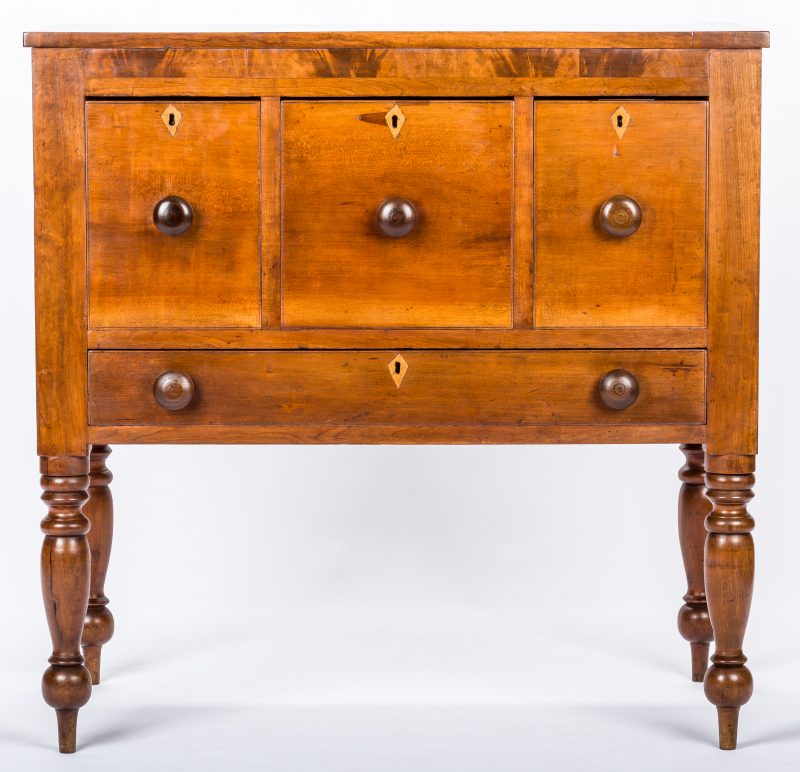 |
|
Middle Tennessee sugar sideboard, possibly Wilson Co. Cherry primary with cherry veneer, poplar secondary. 37 3/4″ H x 38 1/4″ W x 20 1/2″ D. Circa 1820-1830. Note: Two similar examples are illustrated in the book “The Art & Mystery of Tennessee Furniture” by Nathan Harsh and Derita Williams, p. 153, figures 170 & 171. |
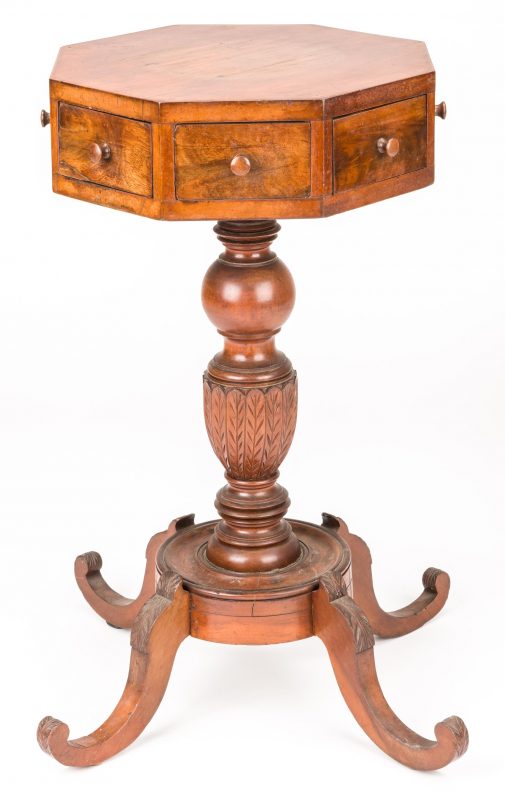 |
|
Kentucky Classical sewing stand comprised of a rotating octagonal top with four dovetailed drawers and four faux drawer fronts over a turned baluster shaped standard with acanthus carving, joined to a circular base with four acanthus carved, scroll-shaped legs. 28 1/4″ H x 25″ W x 17″ D. Circa 1825. |
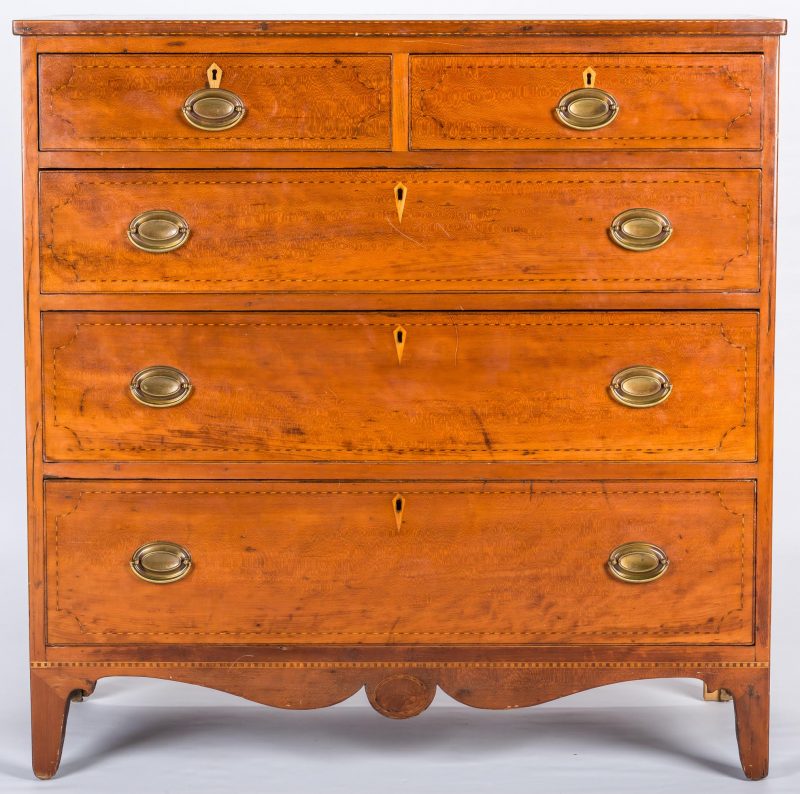 |
|
Kentucky Hepplewhite chest of drawers, attributed to the cabinetmaking shop of Porter Clay (1779-1849), brother of Statesman Henry Clay. Cherry primary, poplar secondary. 40 3/4″ H x 40 1/4″ W x 20 1/2″ D. Circa 1820. More information in the coming weeks. |
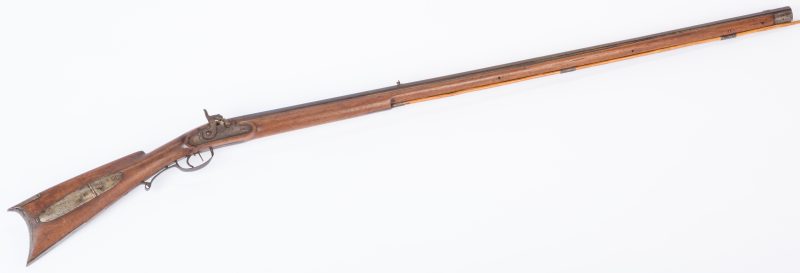 |
|
East Tennessee full stock long rifle with barrel marked in script, “Solomon Reed”. Walnut stock with iron mounts, cigar patch box, octagonal barrel. Percussion converted from a flintlock, .40 caliber. Barrel length – 45″. Overall length – 60″. Biography (courtesy “Notes on Southern Long Rifles” by Jerry Noble): Solomon Reed was born in 1791 and served as a Private in East Tennessee Volunteers in the War of 1812. In the 1820 census he was in Greene County, Tennessee, producing 20 guns at $20 and 40 barrels at $10. |
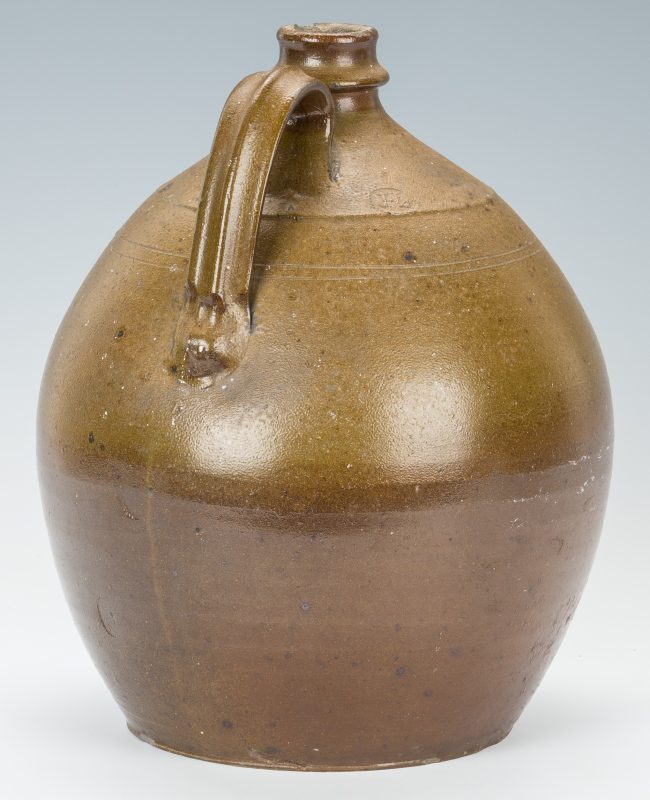 |
|
Middle Tennessee, White County, stoneware pottery jug with transitional tan to brown salt-glaze and applied strap handle. Stamped “JL” within a circle for James LaFever, Sr. (1816 – 1882) on the neck above two incised lines to the shoulder. Additionally stamped “JL” to the lower body beneath the handle. 13 1/4″ H x 9 1/2″ D. Note: For more information about the potter and for examples of his stamp, please see the book “Tennessee Potteries, Pots, and Potters, 1790s-1950, Volume 2” by Samuel D. Smith and Stephen T. Rogers, published 2011, pages 789-790. |
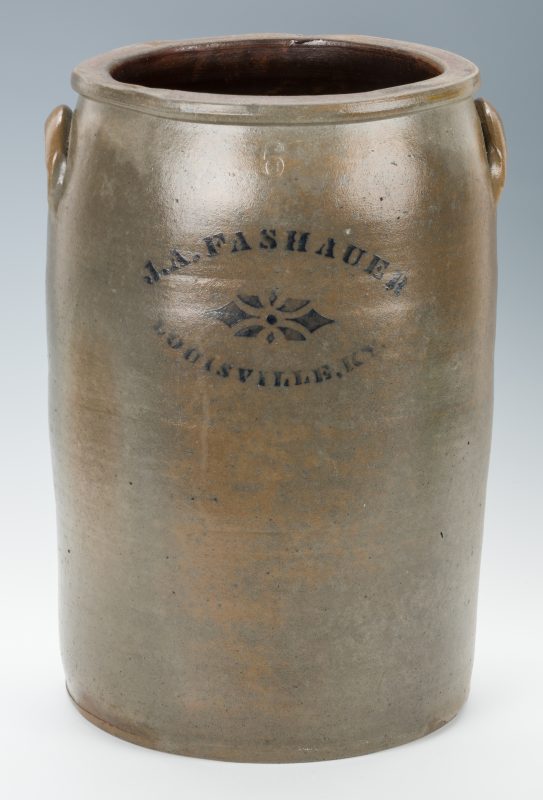 |
|
Kentucky six gallon stoneware jar by John A. Fashauer, Louisville, Kentucky. Tall form with straight sides and lug handles, cobalt stenciled decoration reading “J. A. Fashauer, Louisville, KY”, and stamped 6 below the rim to denote capacity. 16 3/4″H x 12″ D. Estate of Lynn Renau, Louisville, KY. |
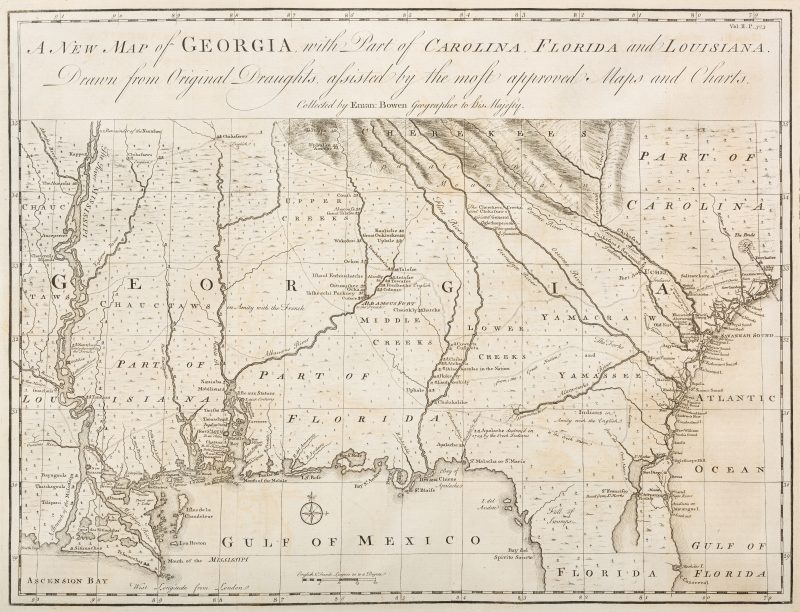 |
|
“A New Map of Georgia, with Part of Carolina, Florida and Louisiana. Drawn from Original Draughts assisted by the most approved Maps and Charts” by Emanuel Bowen, London, 1748. From “Navigantium atque Itinerantium Bibliotheca, or Complete Collection of Voyages and Travels” by John Harris. Copper plate engraving of the Georgia colony, Florida, the Carolinas, and Louisiana, depicting early cities and towns, including St. Augustine and Charleston, and coastal Carolina settlements, mountains, rivers, and other bodies of water, swamp lands, and other points of interest including the Indian Tribes friendly or hostile to the English, and the chief trading paths of the period. Title, centered above map, scale of miles, center left, below map. “West Longitude from London”, lower left of map. Map surrounded by scale notations and line border. Image – 14 3/8″ H x 18 7/8″ W. Plate – 14 3/4″ H x 19 3/8″ W. Sheet – 16 3/8″ H x 20 5/8″ W. |
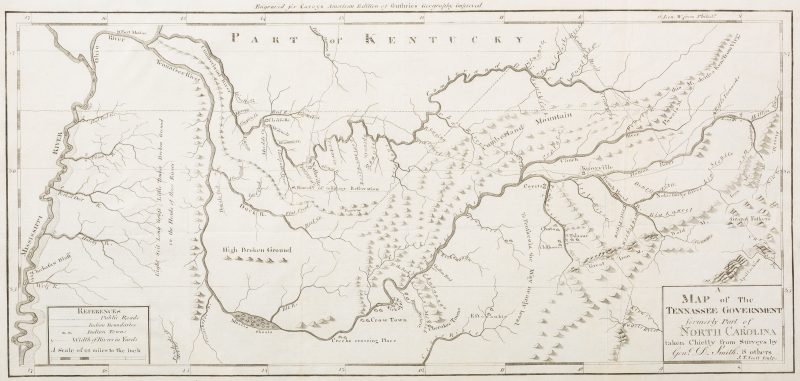 |
|
“A Map of The Tennassee [sic] Government formerly Part of North Carolina taken Chiefly from Surveys By Genl. D. Smith & others” drawn by Daniel Smith, engraved by Joseph T. Scott, published by Matthew Carey, Philadelphia, 1795. From “General Atlas For Carey’s Edition Of Guthrie’s Geography Improved” by Matthew Carey. Copper plate engraving of Tennessee depicting early towns, including Knoxville and Clarksville, rivers and other bodies of water, mountains, forts, and other points of interest including Cherokee Towns such as Nickajack and Crow Town, Ross’s Ironworks, and notations regarding the land. Title, lower right, scale of miles, lower left. “Lon. W. from Philada”, top right above map. Map surrounded by scale notations and line border. Image – 9 1/2″ H x 20 3/8″ W. Plate – 10 1/4″ H x 21 1/8″ W. Sheet – 14 3/4″ H x 22 1/8″ W. |
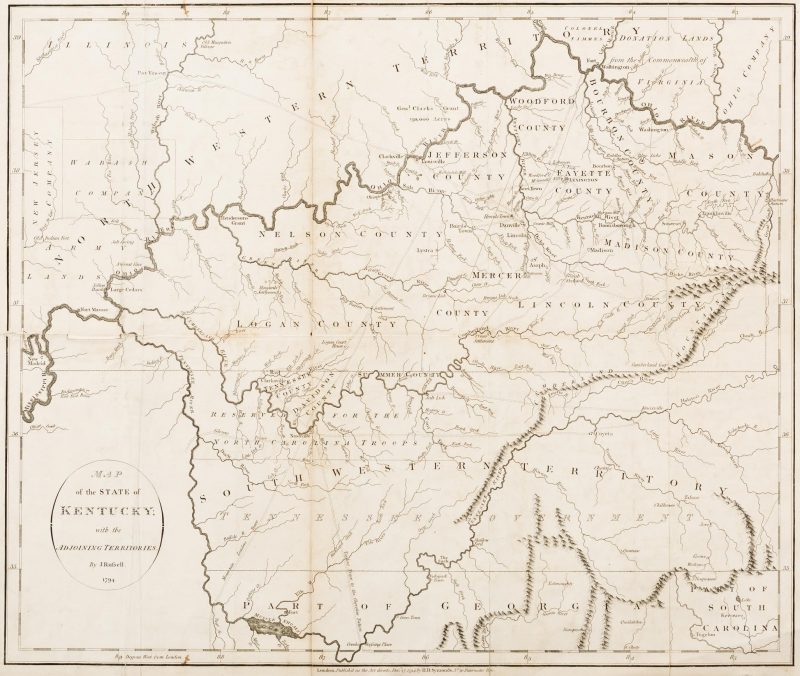 |
|
A MAP OF THE STATE OF KENTUCKY WITH THE ADJOINING TERRITORIES by J. Russell, 1794. London: H.D. Symonds. Includes most of Tennessee, referred to as the “Southwestern Territory” on this map. North of the Ohio River is part of the Northwest Territory, with Fort Washington marked. South of Tennessee and Davidson Counties, is “Reserved for the North Carolina Troops,” land grants for Revolutionary War service. Paper with J. Whatman watermark. Provenance: The estate of Dr. Benjamin H. Caldwell, Nashville, Tennessee. |
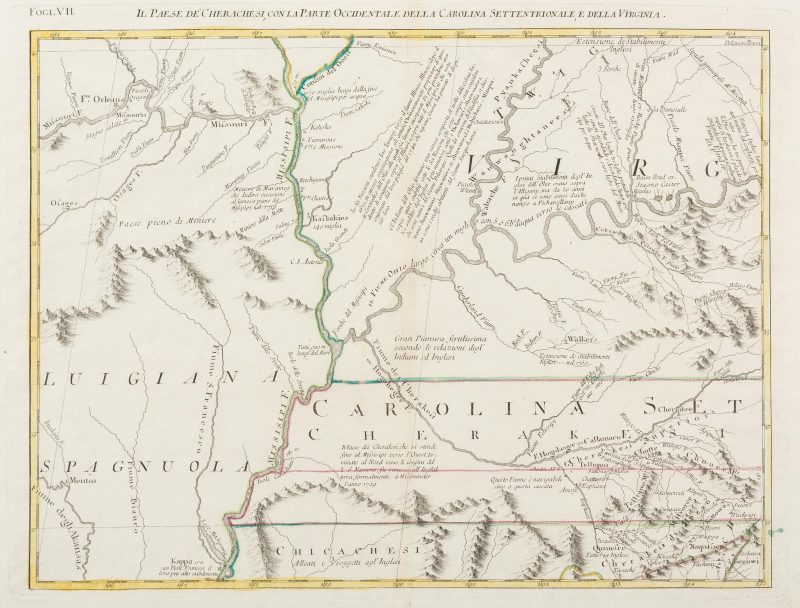 |
|
Antonio Zatta: IL PAESE DE CHERACHESI CON LA PARTE OCCIDENTAL DELLA CAROLINA SETTENTRIONALE, E DELLA VIRGINIA. Section of the Italian edition of Mitchell’s 1773 map of North America, from Storia Dell’America Settentrionale… by Antonio Zatta, John Mitchell, G.T. Raynal (Venice, 1778). Map with outline color engraved on laid paper, depicts a portion of the Southeastern region of the United States from the Appalachian mountains west to the Missouri and Arkansas rivers. Based on John Mitchell’s highly detailed map drawn from the first available English and Indigenous surveys. (Mitchell’s map is considered one of the most important maps of the 18th century). 12 14″ x 16 1/2″ image, 13″ x 17 1/4″ plate, 14 1/2″ x 19 5/8″ sheet. Provenance: The estate of Dr. Benjamin H. Caldwell, Nashville, Tennessee. |
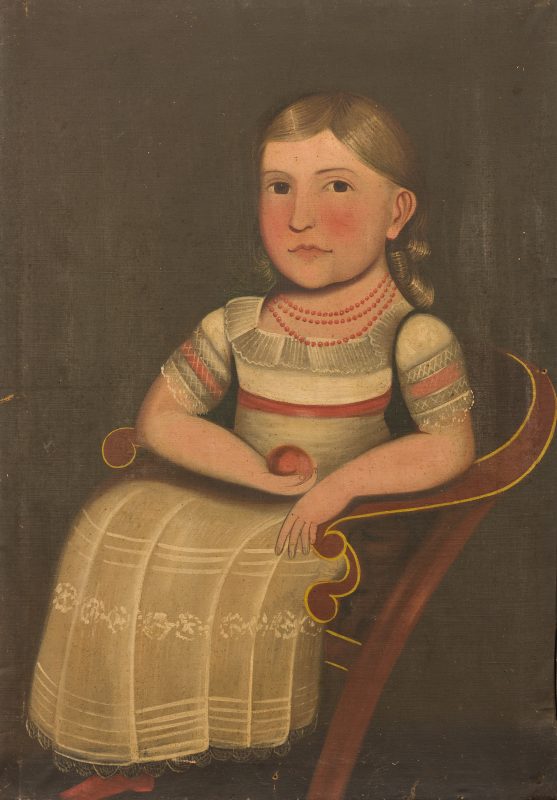 |
|
2nd quarter 19th century folk art painting depicting a child with brown eyes and ringlets, wearing a triple strand coral necklace and lace dress with red sash, seated in a red painted chair with yellow trim, and holding an apple or peach. 28″ x 19 1/2″ . Unframed. Provenance: Painting descended in the Moran family of Woodland Farm in Williamson County, TN, which included the cabinetmaker Charles Moran. (Charles Moran was born in Gates, North Carolina in 1794 and established a cabinetmaking shop in Franklin Tennessee circa 1820). |
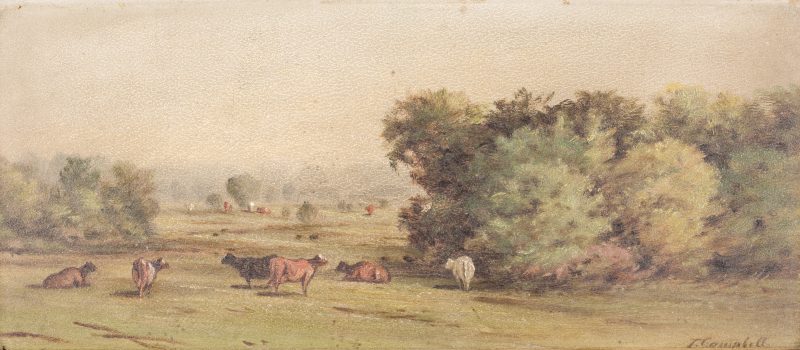 |
|
Thomas Campbell (Tennessee, 1834-1914) oil on board landscape, depicting a meadow with several cows and a grove of trees in the foreground, and more cattle and trees in the background. Signed lower right T. Campbell. Housed in a molded giltwood frame, likely original. 4 1/2″ x 10 1/2″ sight, 8 1/2″ x 14 1/2″ framed. |
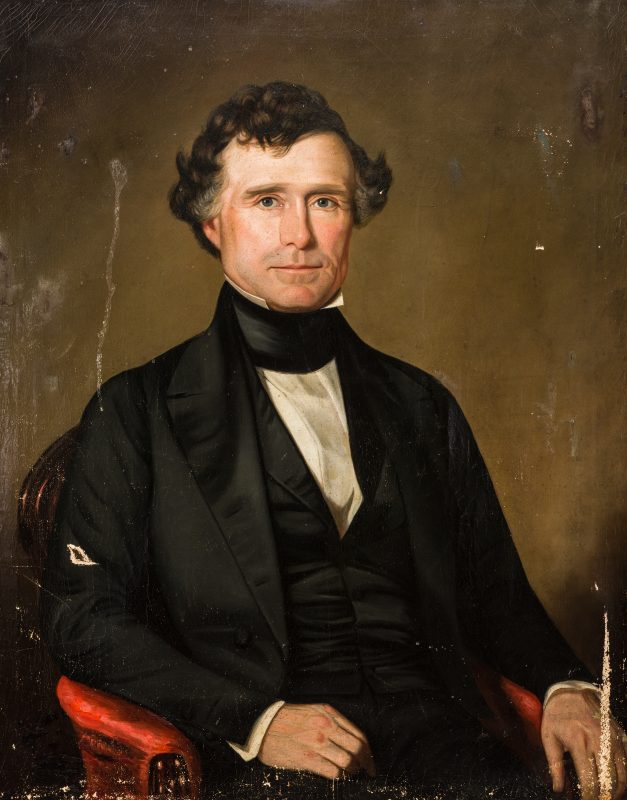 |
|
East Tennessee portrait of gentleman by Samuel Shaver (TN, 1816-1878). This portrait has a oral history of descending through the McWhorter family of Knox Co. Sight 35 1/2″ H x 28 1/2″W. Framed 39″ H x 32″ W. |
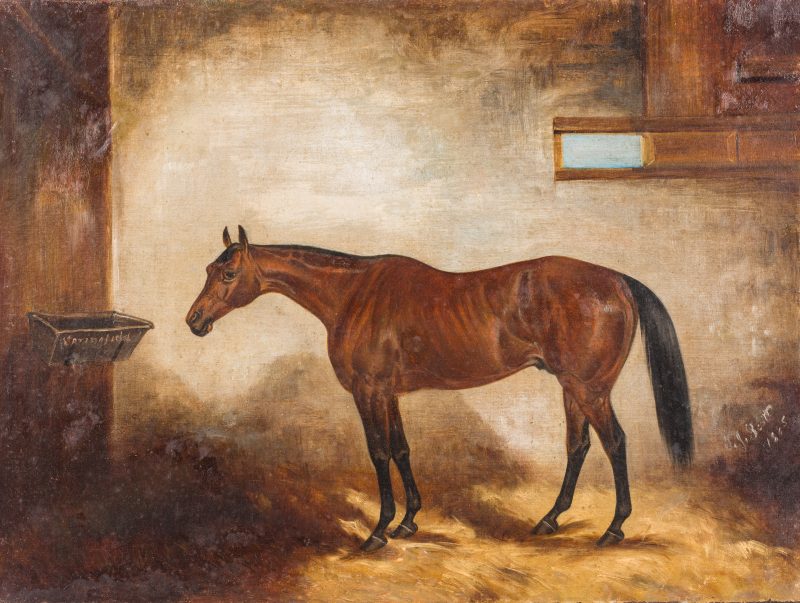 |
|
Oil on canvas of “Springfield, Belle Meade Plantation Stock,” by Thomas J. Scott, dated 1885. Exhibited, “The Horse in Decorative and Fine Art – Selections of Outstanding Equine Art Represented in National and Kentucky Collections,” 2010, at the Headley-Whitney Museum in Lexington, Kentucky; illustrated in the 2010 exhibition catalogue ” A Troye Legacy: Animal Painter, T. J. Scott ” by Genevieve Baird Lacer on page 49. Estate of Lynn Renau, Louisville, KY. More in the coming weeks… |
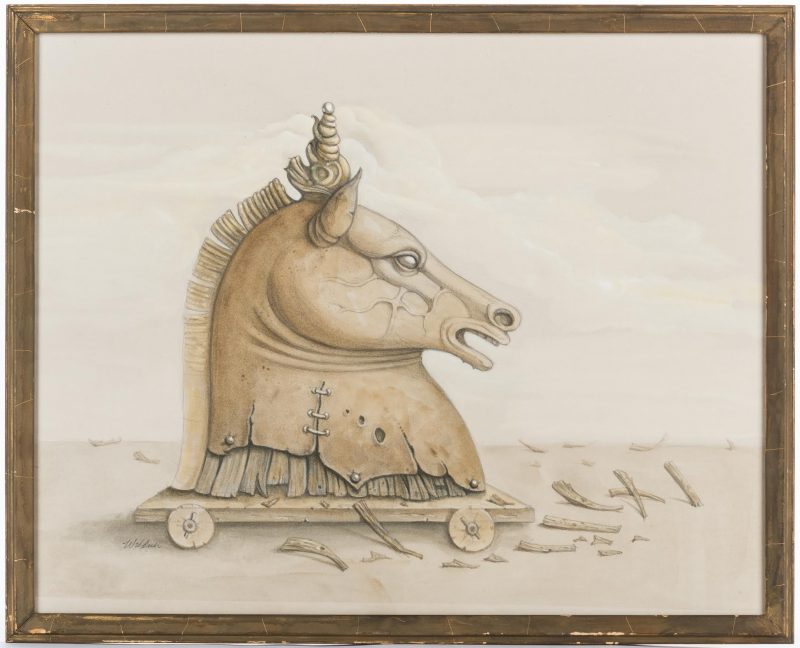 |
|
Werner Wildner (Nashville, Tennessee, 1925-2004) graphite and watercolor on paper depicting a unicorn’s head on wheeled base, with several broken articles strewn on the ground beside it, all set against an empty horizon. Signed “Wildner” lower left. Artist’s address label affixed en verso with street address marked out and “118 Louise Ave.” written in. 15 1/2″ x 19 1/2″ sight, 17″ x 21″ in giltwood frame. |
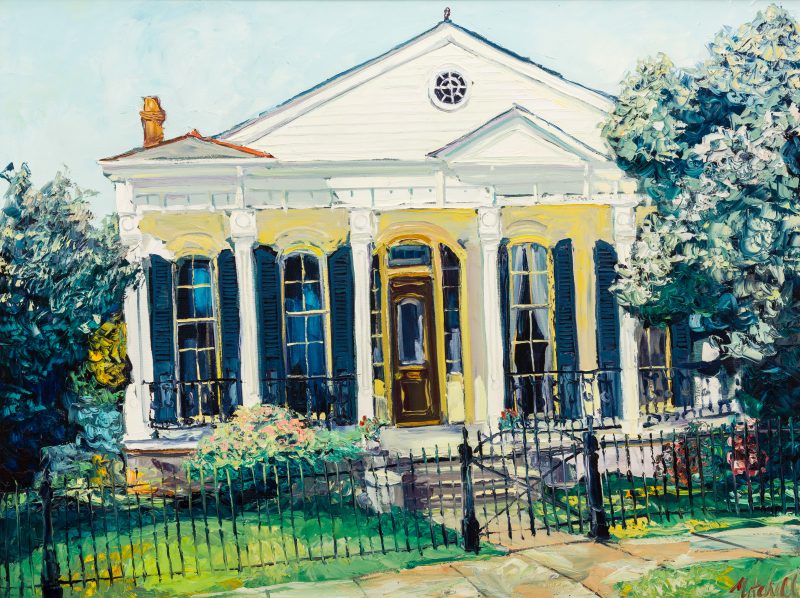 |
|
James Michalopoulos (b. James Mitchell, 1951, American/Louisiana), “Pristine At Prytania,” large oil on canvas painting depicting a traditional New Orleans style home with tall front windows and and iron railed porch and street fence. Signed lower right in red “Mitchell”. Titled en verso. Sight – 35 1/2″ H x 47 3/8″ W. Framed – 43 1/2″ H x 55 1/2″ W. |
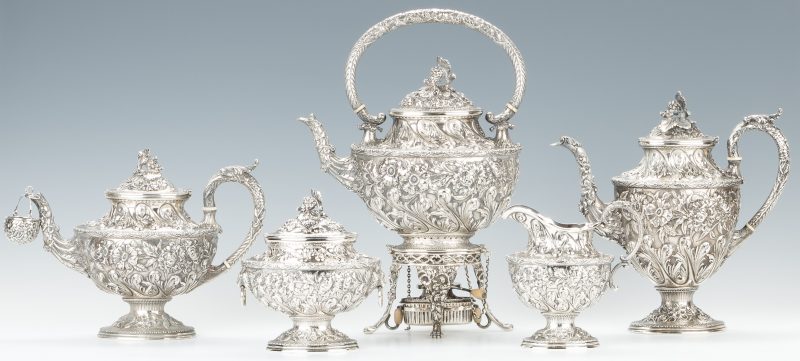 |
|
Samuel Kirk & Son repousse sterling silver tea service, 6 pieces, comprised of a kettle on stand with burner, coffee pot, tea pot, creamer, small tea strainer, and covered sugar bowl having lion mask ring handles. Each piece marked on the base “S. Kirk & Son Co., 925/1000”. Kettle measures: 15″ H x 11″ W. Coffee pot measures: 11 1/2″ H. Teapot measures: 9″ H. Sugar bowl measures: 7 1/2″ H. Creamer measures 8 1/2″ H. 199.50 total troy ounces. Circa 1907. |
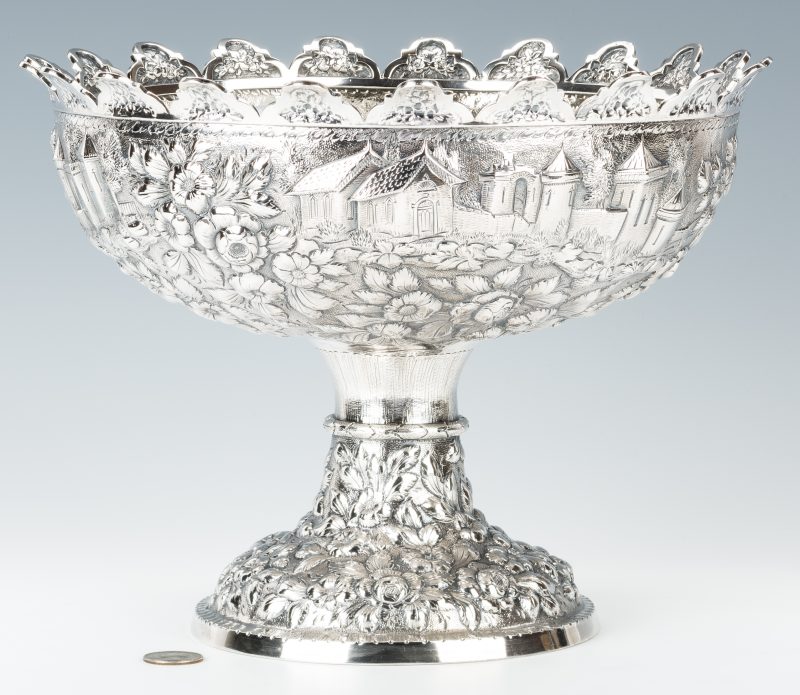 |
|
American coin silver footed Monteith bowl with architectural and floral repousse decoration. Side of base marked “C. B. & Co.”, possibly a retailer, and two other illegible hallmarks. 9 1/4″ H x 11 3/4″ dia. 45.315 troy ounces. |
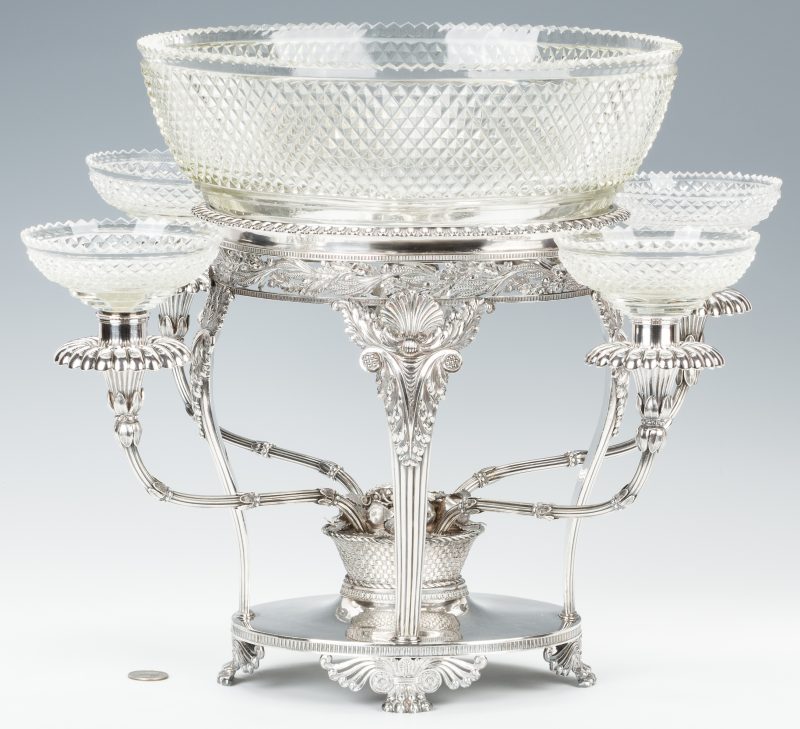 |
|
English George III sterling silver epergne, 1811, London, with maker’s mark ”IWS / WE” for J. W Story & W. Elliott. |
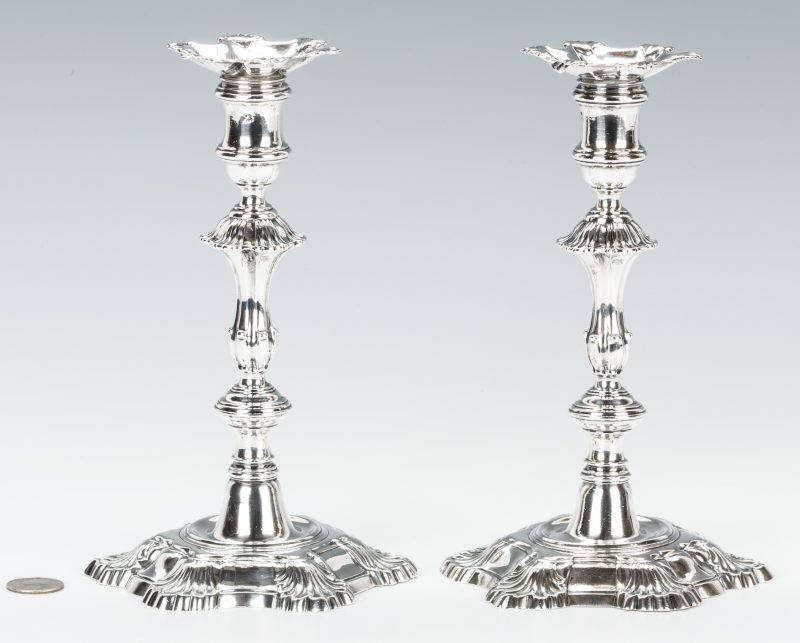 |
|
Pair of George II sterling silver candlestick, London, 1750, with maker’s marks “W.G.” for William Gould. |
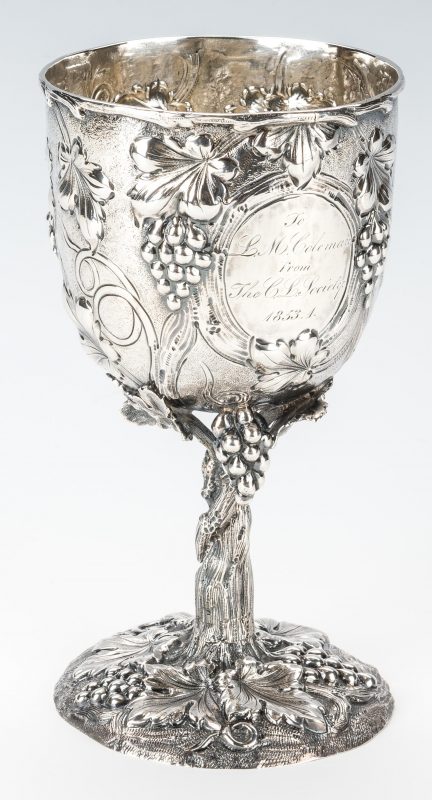 |
|
Mitchell & Tyler (Richmond, Virginia, working 1845-1866) coin silver presentation repousse goblet, presented to L. M. Coleman (Lewis Minor Coleman Virginia, 1827 – 1863) by The C. L. Society, 1853-4. Mitchell & Tyler stamp mark to inner rim edge on base. 7 1/8″ H. 9.535 troy ounces. Biography: Lewis Minor Coleman born in Hanover county, Virginia, February 3, 1827; graduated with high honors at the University of Virginia in 1846. In 1861, Coleman joined the Confederate army as captain of a Virginia artillery and was later promoted to the rank of lieutenant colonel of artillery in 1862. Coleman was severely wounded at the battle of Fredericksburg, VA December 13, 1862 and died three months later in March, 1863 (Courtesy: Encyclopedia of Virginia Biography, Volume III, By: Lyon Gardiner Tyler, LL. D., Lewis Historical Publishing Company, New York 1915). More information in the coming weeks. |
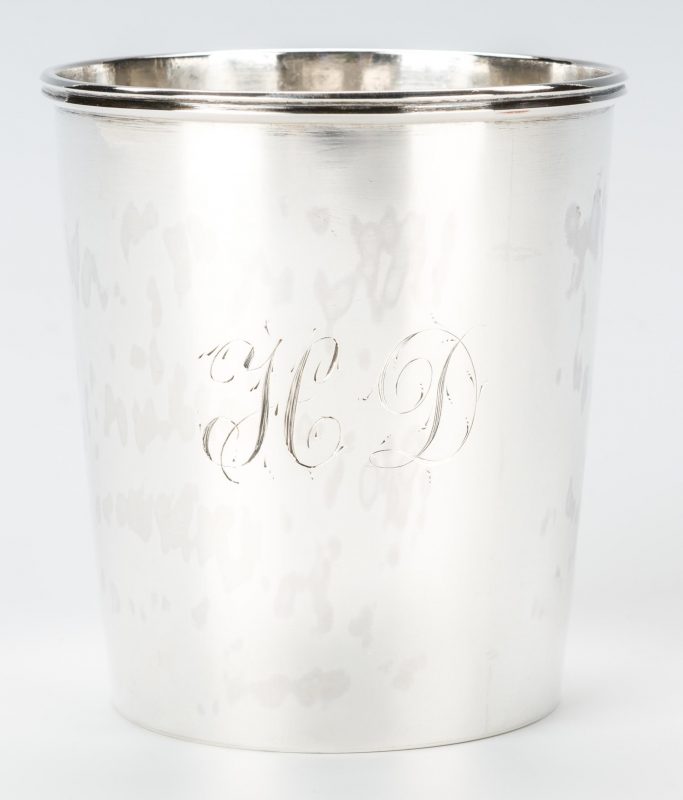 |
|
Joseph Loring (Boston, 1743-1815) Federal coin silver cup, having script J. Loring within a cartouche mark to the base. Initials on the side “HD” for Major General Henry Dearborn. Henry Dearborn served on General Washington’s staff in Virginia. He was US Secretary of War, serving under President Thomas Jefferson from 1801 to 1809, and served as a commanding general in the War of 1812. Inscription on the base reads, J. E. D. C. / A. M. D. B. (Annette Maria Dearborn Boyd) / Sept. 1858, Sept. 1883. 3″ H. 2.660 troy ounces. |
 |
|
Antique French yellow gold and shell cameo parure consisting of tiara, drop earrings and brooch in original fitted case. Shell cameos depicting male and female mythological figures including two with large dogs, all mounted in pierced Greek key and scroll work settings. Gold not marked, tested electronically as 17K to 18K. No maker’s marks. Parure presented in original fitted hinged green leather gilt decorated domed box marked on base “Janisset, Passage des Panoramas No 61”. 4″ H x 5-5/8″ w x 7-3/8″ D. Passage des Panoramas was established in 1799 as one of the early glass covered indoor shopping venues in Paris. Tiara with hinged bands: 1-7/8″ H x 21″ W, 30.1 grams. Drop dangle earrings: 2-5/8″ L, 15.7 grams with replaced 12K gold-filled screw-backs. Brooch: 1-1/4″ h x 2-1/4″ W, 7.9 grams. 53.7 grams tw including replaced GF earring backs. Circa 1810. More information in the coming weeks. |
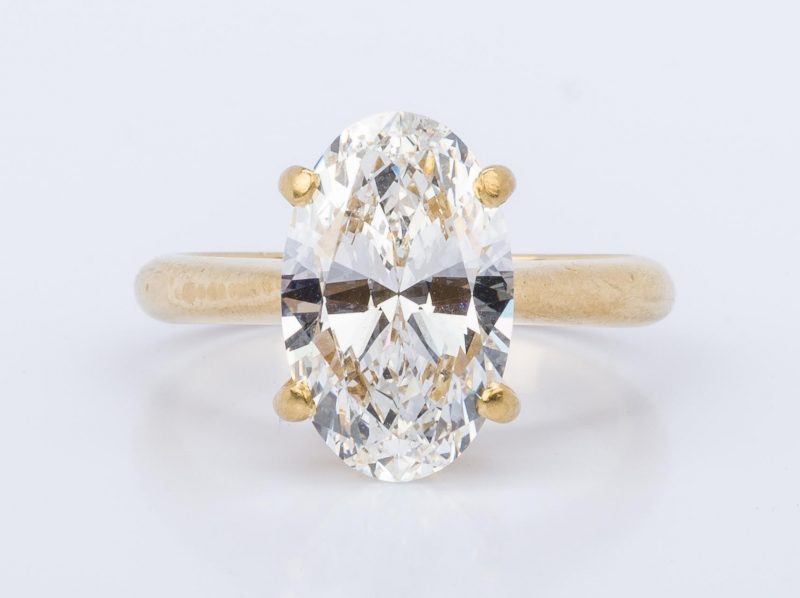 |
|
3.13 carat oval brilliant cut diamond set in classic 4-prong 18K yellow gold ring mounting. The oval diamond measures 12.50 x 7.86 x 4.63 mm and is F color, VS1 clarity. Polish: Excellent, Symmetry Very Good, Fluorescence: Faint. Ring size: 5 1/2 slight. GIA report number 1182887169, dated November 20, 2017. |
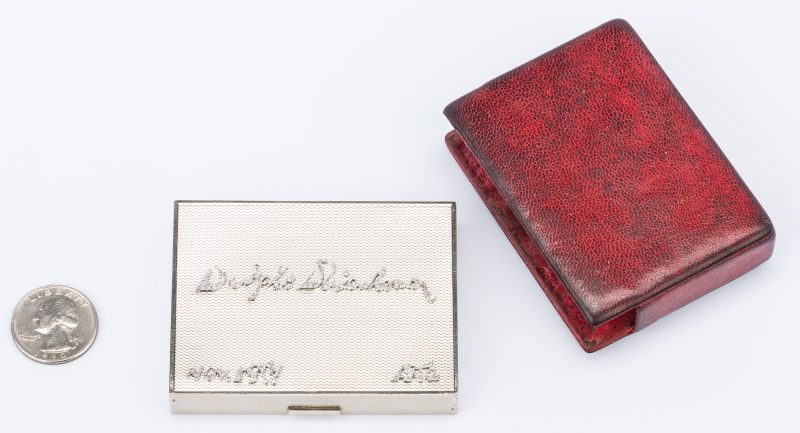 |
|
14K Platinum Dwight D. Eisenhower Presentation gift, marked “14K Plat”. Diamond Eisenhower signature and date, “Nov. 19th 1952” in relief on top. |
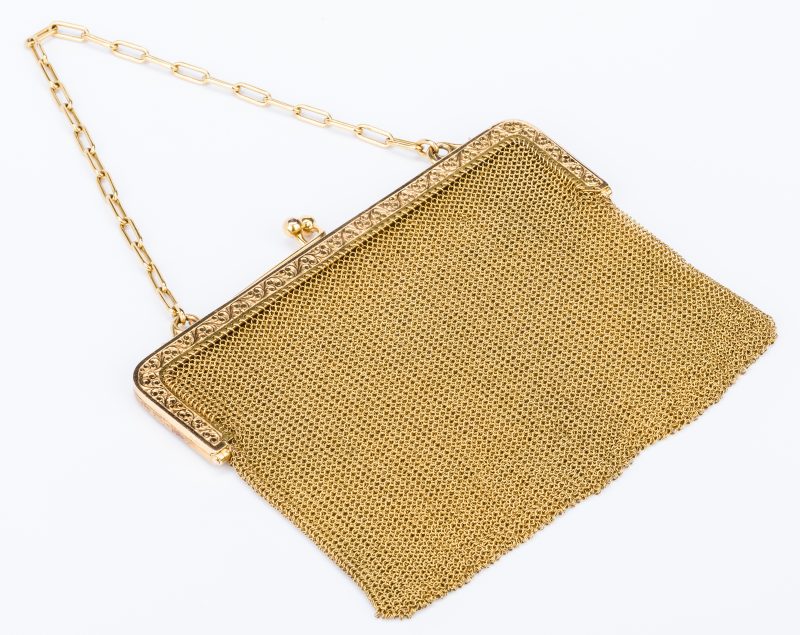 |
|
French 18K yellow gold mesh purse, rectangular mesh pouch on shaped rectangular frame, the front with incised trefoil scroll decoration. 207 grams. Provenance: Estate of Dr. Benjamin Caldwell, Jr., Nashville, Tennessee. |
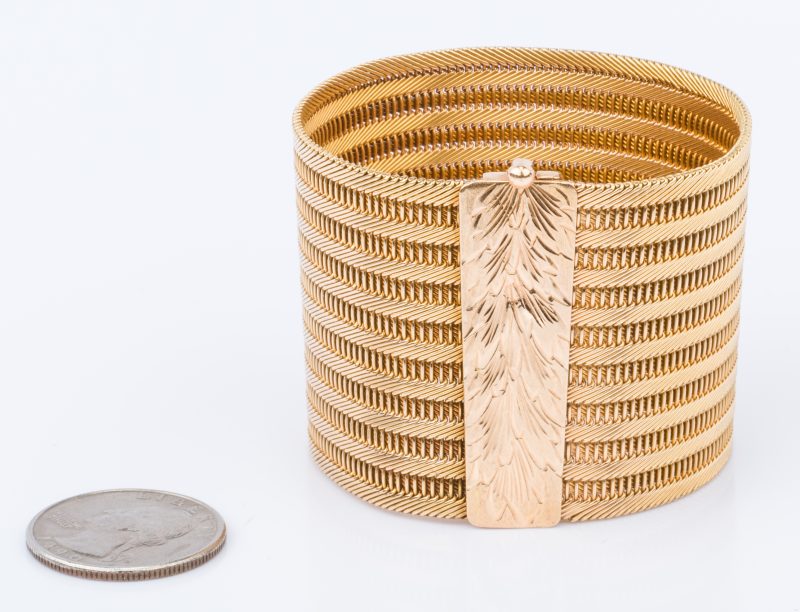 |
|
Italian 18K rose gold wide woven cuff bracelet with incised leaf spray clasp, marked NA for Napoli, 1 3/4″ W x 7″ base x 6 5/8″ top. 74.9 grams. Mid-20th century. |
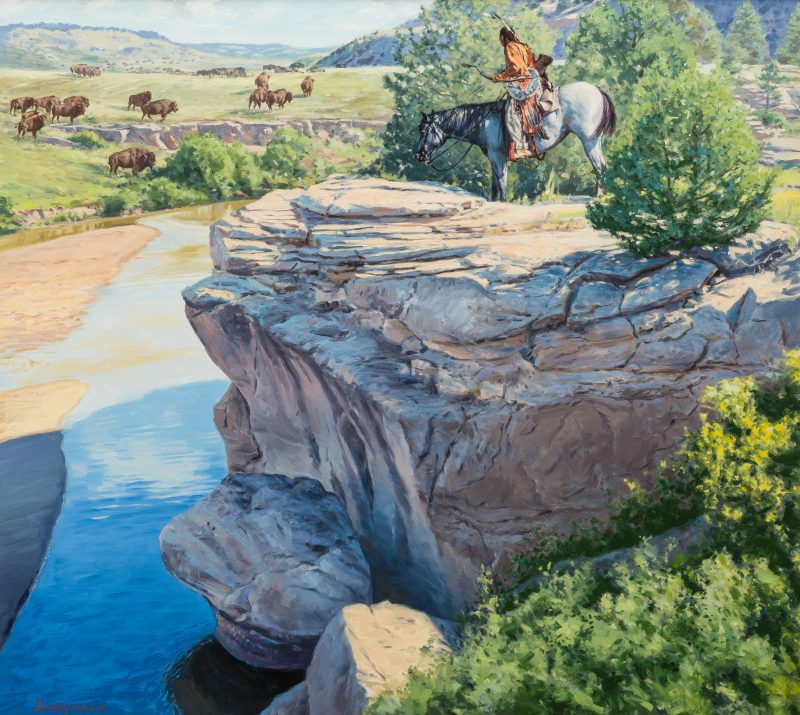 |
|
David Yorke (American, b. 1949), “Separate Paths,” oil on canvas painting depicting a Native American brave on horseback atop a cliff situated above a river, gazing at a herd of buffalo in the distance. Signed and dated “David Yorke” with copyright symbol, lower left. Sight – 35″ H x 39 1/2″ W. Framed – 44″ H x 48 3/4″ W. |
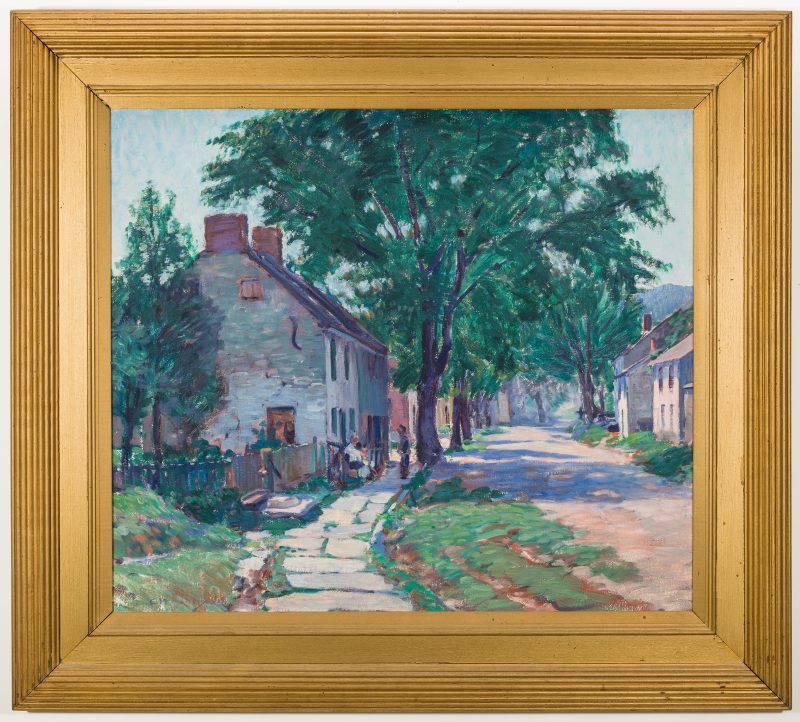 |
|
Clifford Warren Ashley (Massachusetts, 1881-1947) oil on canvas landscape painting of a village street scene, with figures conversing in front of a house. Signed lower left. Sight – 25 3/8″ H x 29 3/8″ W. Framed – 35 1/4″ H x 39 1/4″ W. |
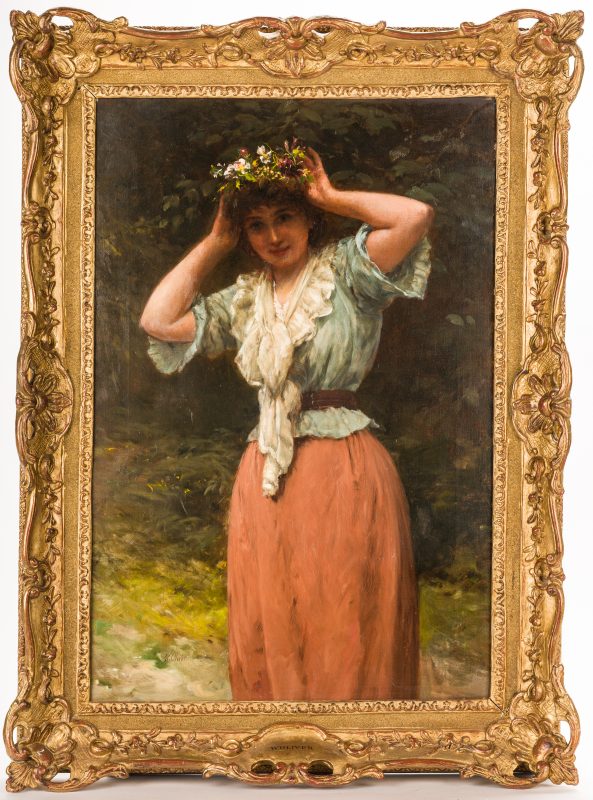 |
|
William Oliver the Younger (France/United Kingdom, 1823-1901) oil on canvas painting depicting a young woman adjusting a wreath of flowers in her hair. Signed “W. Oliver” lower left. Handwritten label reading “From the Collection of Sir Clifford J. Cory, Llantarnam Abbey, Monmouthshire” with The Cooling Galleries, London label, en verso of frame. Stamp reading “Prepared by Winsor & Newton, Limited, 33, Rathbone Place, London, en verso of canvas. Housed in a carved gilt wood pierced center and corner frame, labeled “W. Oliver”, lower center of frame. Sight – 29 1/4″ H x 19 3/8″ W. Framed – 37 1/4″ H x 27 1/4″ W. |
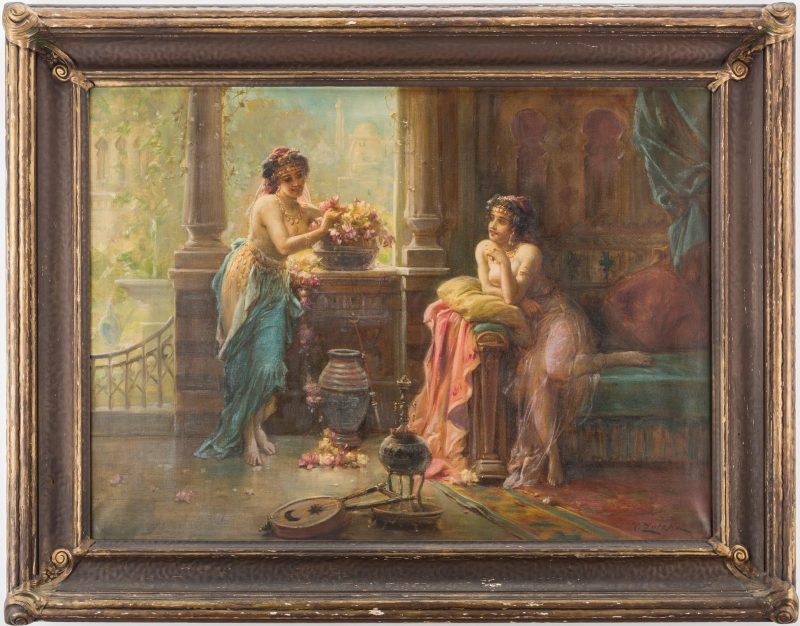 |
|
Hans (Ronsard) Zatzka (Austria/Italy, 1859-1945) oil on canvas Orientalist scene, depicting two harem females in an interior with balcony and cityscape in the background, one standing by a window arranging flowers and the other seated on a bed with musical instruments, hooka and oriental rug on the floor below. Signed lower right “H. Zatzka” lower right. Housed in the original carved and textured gilt frame. Sight – 22 1/2″ H x 30 3/4″ W. Framed – 30 3/4″ H x 39″ W. |
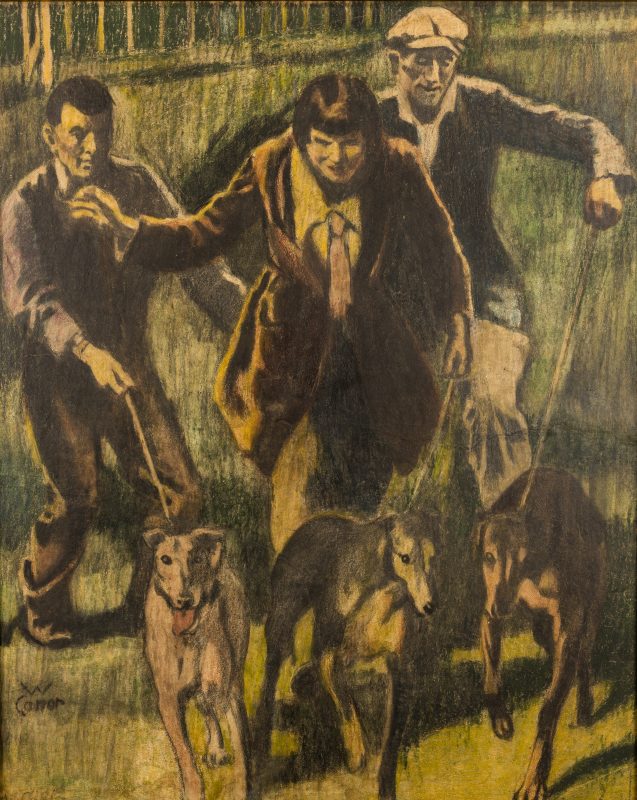 |
|
William Conor (Irish, 1881-1968, RUA RHA), crayon, oil, and paper on board painting, “Exercising the Greyhounds.” Sight 28 3/4″ H x 23 3/4″ W. Framed 38″H x 33″ W. More information in the coming weeks. |
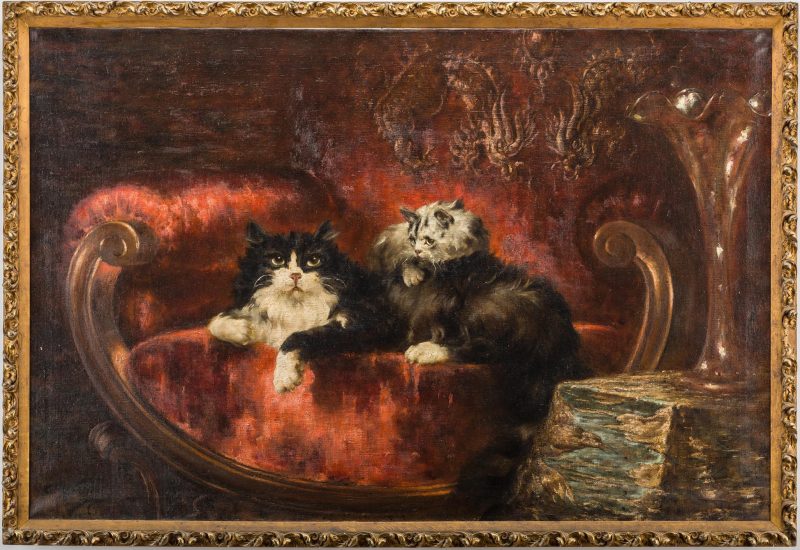 |
|
Carl Kahler ( NY/California/Australia/Austria, 1855-1906) large oil on canvas painting depicting a Persian cat with green eyes and kitten posed on a red velvet couch. Housed in the original gilt carved wood frame. Sight – 31 1/2″ H x 47 1/2″ W. Framed – 34 3/4″ H x 51″ W. |
|
|
|
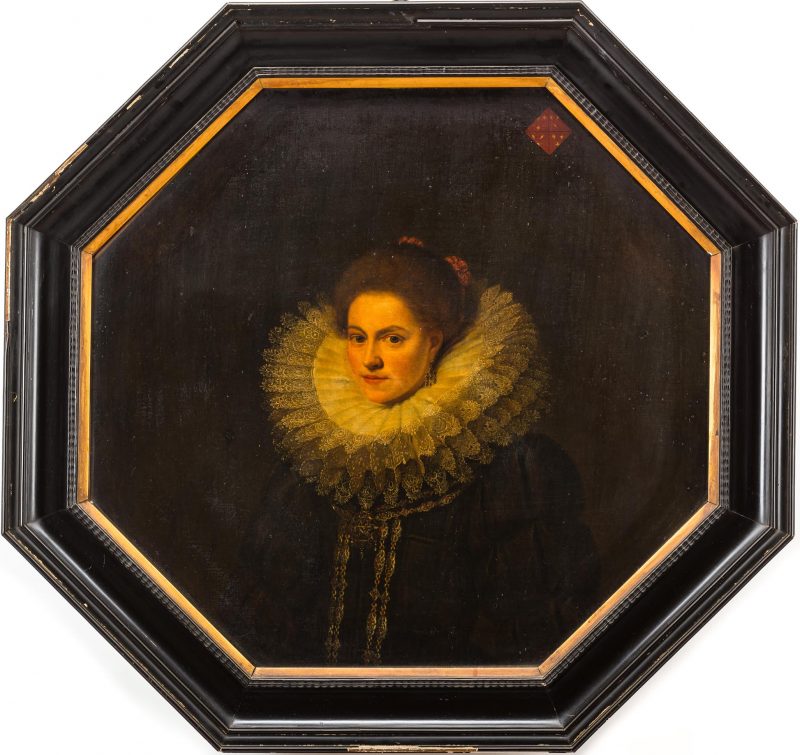 |
|
Large 17th century Flemish School portrait of a noblewoman in the manner of Cornelis de Vos or Rubens. More information in the coming weeks. |
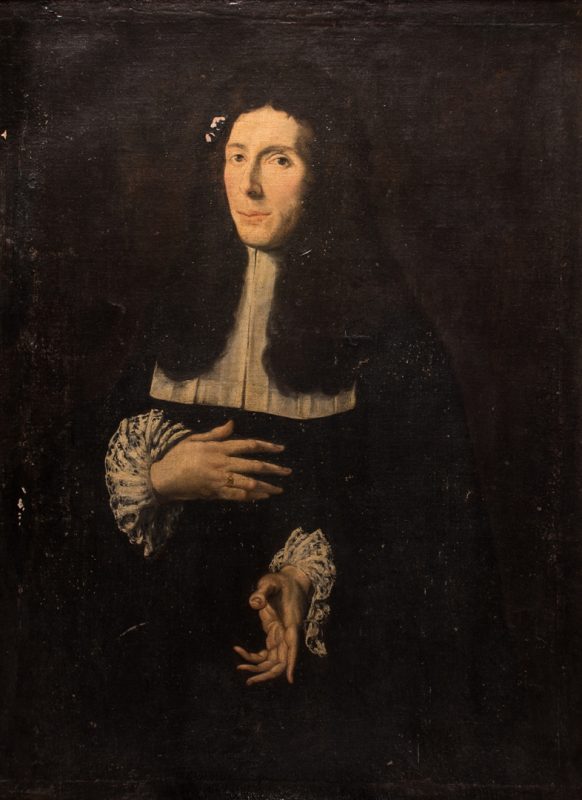 |
|
Continental School, 17th Century, Large portrait of a gentleman in the original frame. Provenance: a Virginia estate. More information in the coming weeks. |
|
|
|
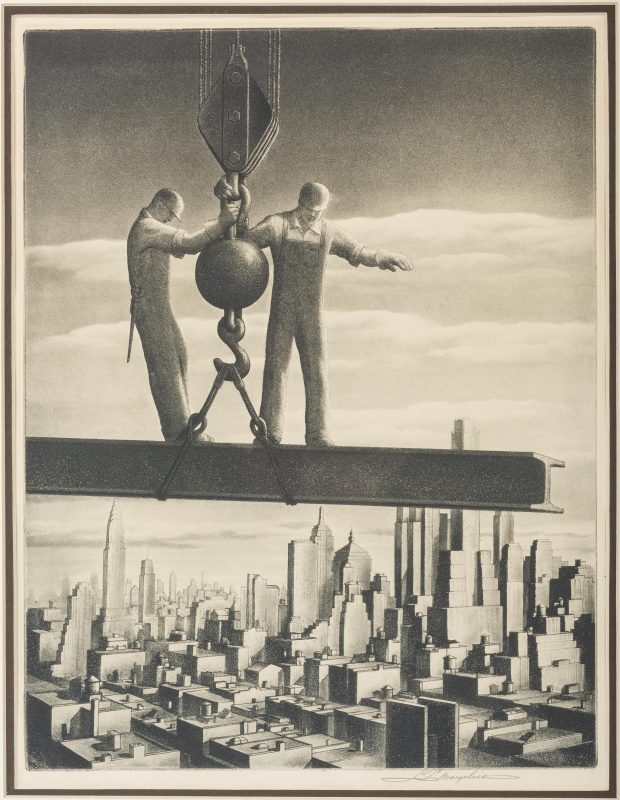 |
|
Samuel L. Margolies (American, 1897 – 1974) aquatint and etching, “Builders of Babylon,” 1937, depicting construction workers atop a steel I-beam with the New York City skyline below. Pencil signed in the lower right margin. Published by the Associated American Artists, New York, edition of 250. Matted and framed in a chrome colored metallic frame. 14 3/4″ H x 11 1/4″ W. Framed – 22 1/2″ H x 18 1/2″ W. |
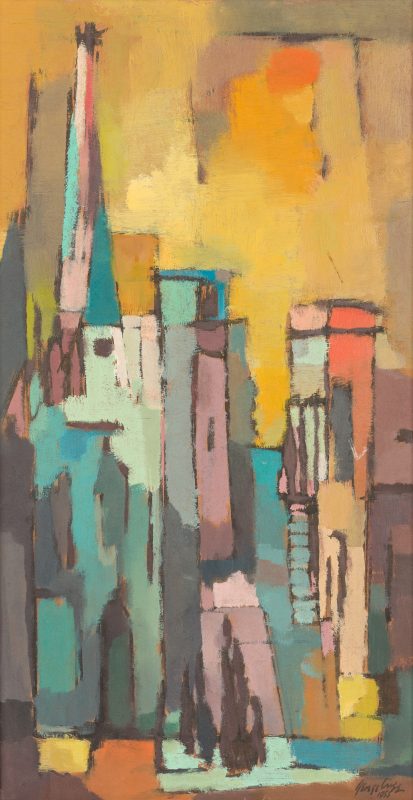 |
|
George Ayers Cress (Alabama/Tennessee, 1921-2008) oil on board abstract painting titled “City Shawdows,” depicting a cityscape with church and steeple on left. Signed and dated “George Cress 1955” lower right. |
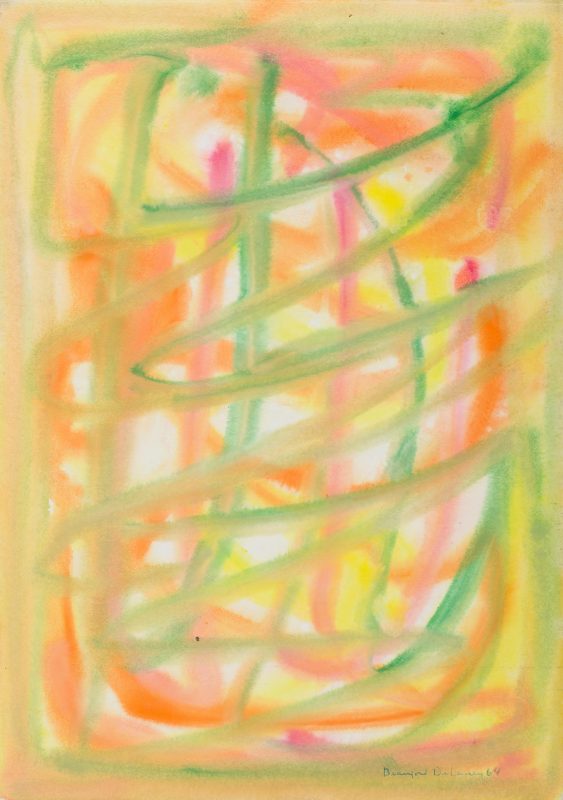 |
|
Beauford Delaney (American, 1901-1979) abstract watercolor on paper. Estate of Beauford Delaney, Derek L. Spratley, Esquire, court-appointed administrator. More information in the coming weeks. |
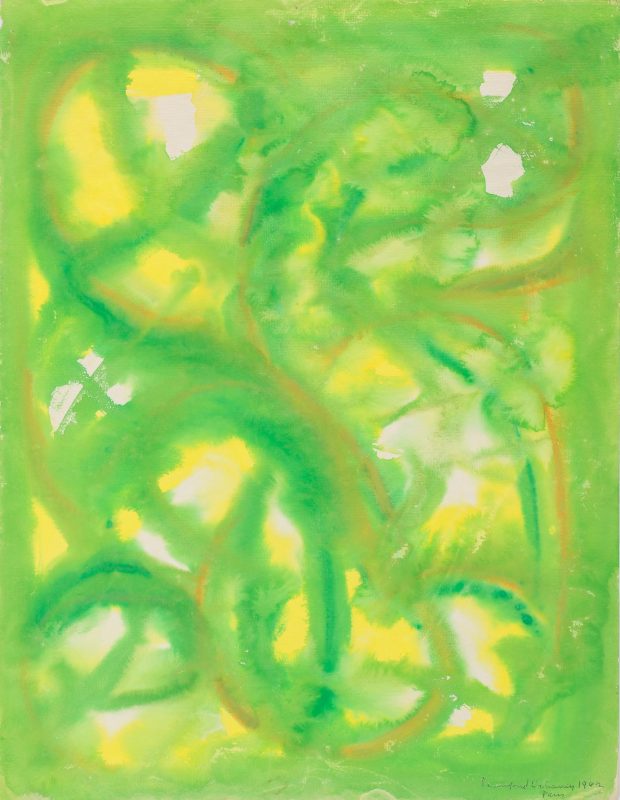 |
|
Beauford Delaney (American, 1901-1979) abstract watercolor on paper. Estate of Beauford Delaney, Derek L. Spratley, Esquire, court-appointed administrator. More information in the coming weeks. |
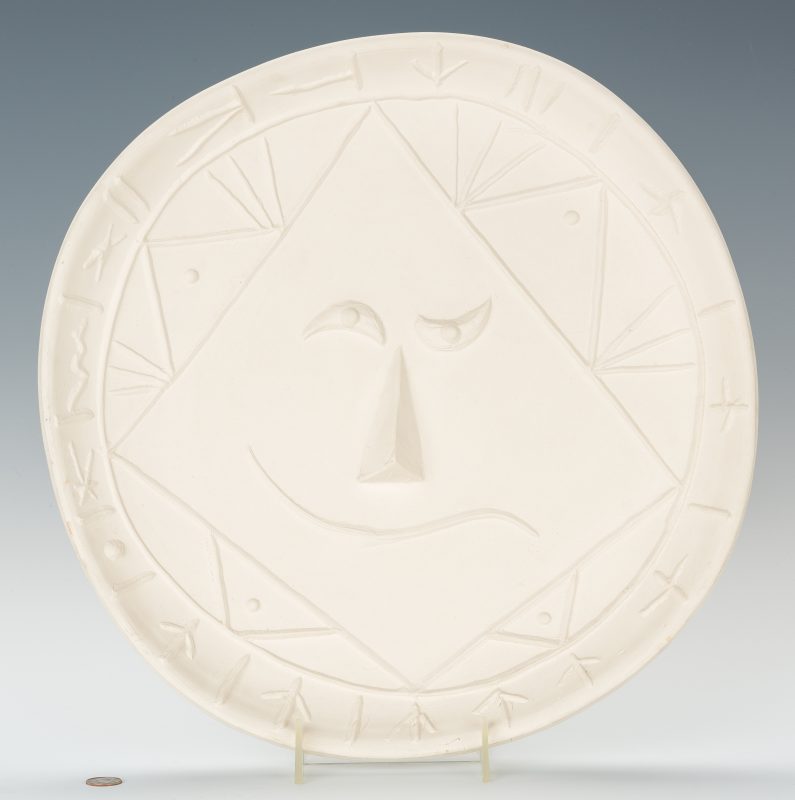 |
|
Pablo Picasso (Spanish, 1881-1973) unglazed ceramic plate titled “Visage” by Madoura Pottery. Stamped en verso “Madoura Plein Feu/Empreinte originale de Picasso”. Inscribed en verso “A102″ and numbered in black marker 20/100. 14 1/2” dia. Circa 1965. |
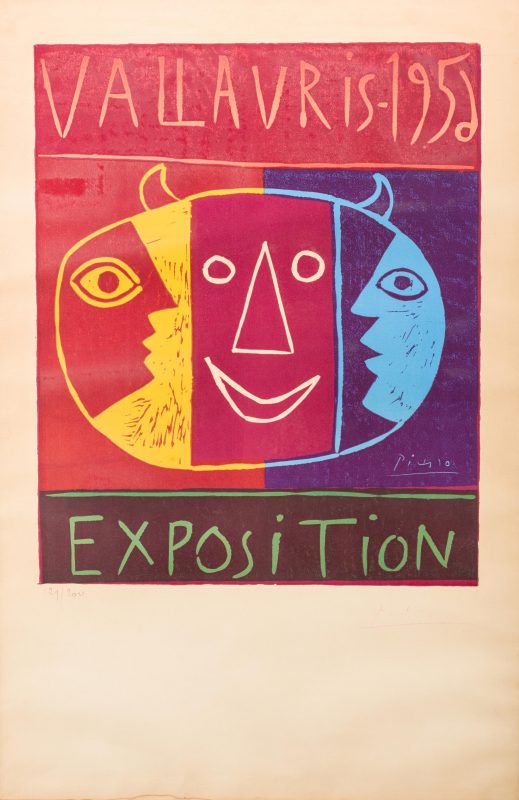 |
|
Pablo Picasso (Spanish, 1881-1973) signed Vallauris 1952 Exhibition Poster, 1956, linocut in colors on Arches watermarked paper, signed lower right in red crayon and in the plate, and numbered lower left 29/200 in pencil. Publisher: Association des Potiers de Vallauris, France: Literature: Bloch 1271, Baier 1042 B. Framed under glass in metallic and stained wood frame. 39″ x 25 3/4″ sight, 40″ x 27″ framed. Provenance: Private Birmingham, Alabama collection. Note: In 1946, Picasso visited the annual pottery exhibition at Villauris, a town in the south of France renowned for its ceramics. There, he met Suzanne and Georges Ramie, owners of the Madoura Workshop. Picasso became so enamored of ceramics that he moved to Villauris and lived there from 1948 to 1955. During this time, he created many sculptures and ceramics in collaboration with the Madoura Pottery; he also developed a fascination for the linocut process, which was used to produce this poster. |
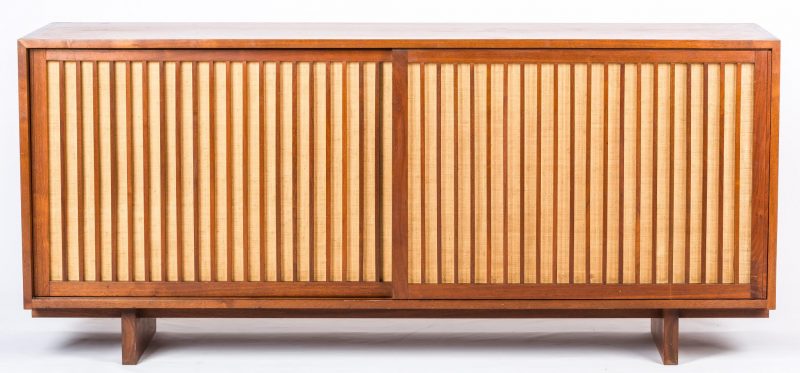 |
|
George Nakashima (1905-1990) mid century modern walnut credenza, pinned and dovetailed case construction with two vertical slat sliding doors backed with pandanus cloth concealing a fitted interior comprised of adjustable shelves on the left side and pull out drawers on the right side. Unmarked. 32″ H x 72 1/8″ W x 20″ D. Provenance: Private Knoxville, TN estate. |
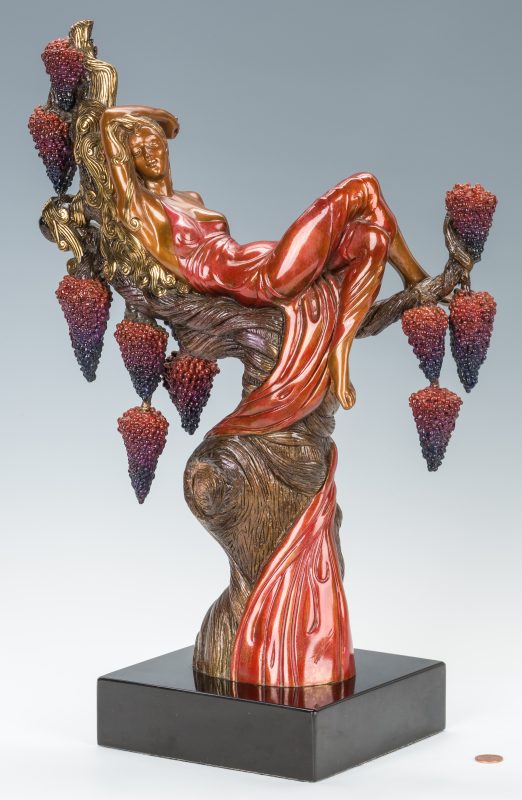 |
|
Erte (Romain De Tirtoff, Russian/French, 1892-1990), limited edition gilded and cold painted cast bronze sculpture titled Heat. Inscribed “Erte”, numbered 198/375, Chalk & Vermilion and Seven Arts inscriptions, and dated 1989 on the front edge of the base. 19 1/4″ H x 13″ W x 61/2″ D. |
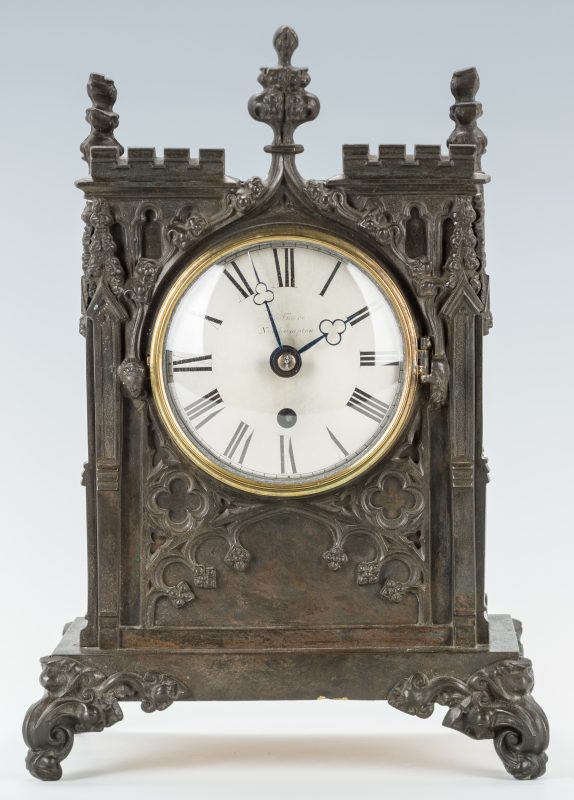 |
|
English bronze architectural Gothic Revival mantel clock, having a silvered clock face with Roman numerals marked “Whitmore/Northampton”. 15 1/8″ H x 10 1/2″ W x 6 1/2″ D. Mid-19th century. Note: An identical clock is on exhibit at the New York Metropolitan Museum of Art, Gallery 740 – Gothic Revival Library. |
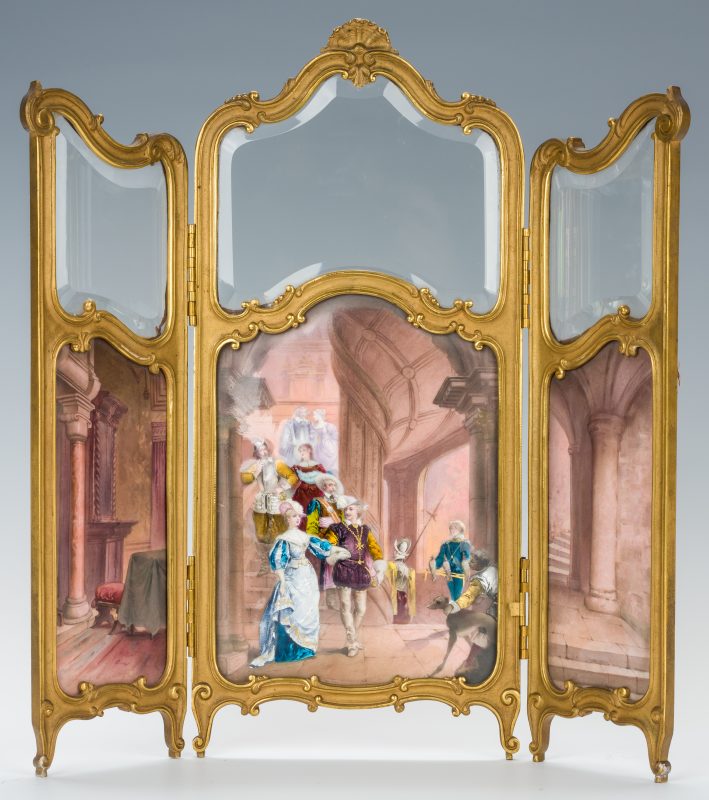 |
|
A French enamel and gilt bronze 3-panel table screen, each enameled panel depicting a castle interior including a central enamel panel of figures descending a staircase. The upper section of each panel fitted with beveled glass. 15 1/2″ H x 15 3/4″ W (fully extended). 19th century. |
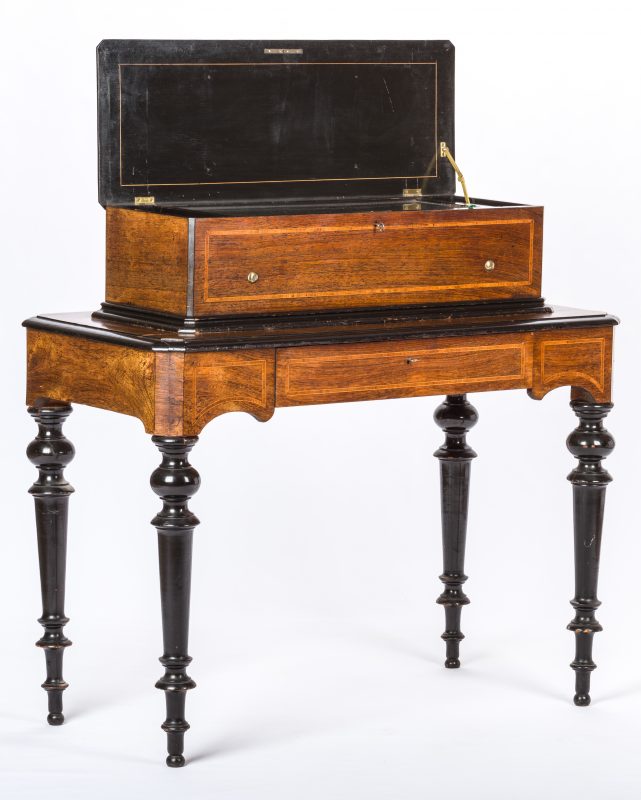 |
|
Swiss cylinder music box on stand. Rectangular rosewood inlaid case with ebonized corners, stand of inlaid rosewood with a center drawer storing two of the three 13″ interchangable cylinders, all on tall ebonized turned legs. Interior fitted with a glass protective lid and a 13-inch cylinder music lever mechanism. Lever marked “2650 B”. Cylinders marked on the ends, ’31 B, 32 B, and 33 B” and each plays 8 tunes. All teeth present on comb. Music box fully functional. Box measures 8 1/2″ H x 31 1/2″ W x 12 1/2″ D. Stand measures: 29 1/2″ H x 40 1/2″ W x 21″ D. Late 19th century. Part of a collection of mechanical music to be offered in this auction. |
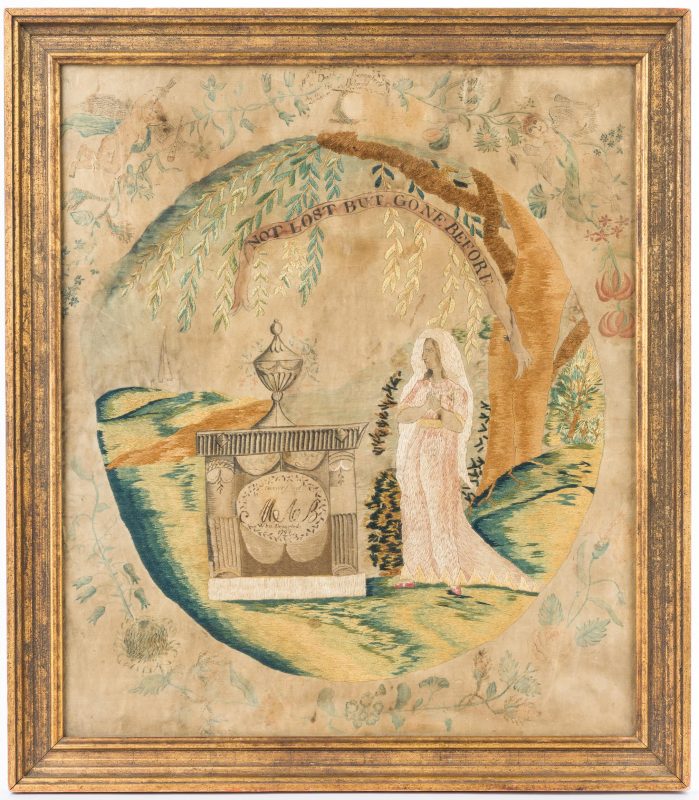 |
|
Early 19th century watercolor and embroidered silk mourning picture, attributed to Margaret Brock of Abbeville, South Carolina (1794-1853). Oval vignette features a female figure standing beneath a weeping willow tree, beside an urn and pedestal which reads “In memory of MAB who departed 1794”. Banner above reads “Not Lost but Gone Before.” The corners of the work are decorated with watercolor flowers and cherubs; script above reads “In death remembered as in life beloved”. Later giltwood molded frame. 19″ x 16 1/4″ sight, 22″ x 19 1/4″ framed. Handwritten inscription verso “Roxie Campbell / 200 E. 1st Ave. Lenoir City Tenn”. Note taped below from Bobbie Chambers Nash, dated 1982, recounts that she found the work in the attic of a Knoxville TN home owned by her brother Dr. Shirley Coleman Chambers and thought it might have belonged to the home’s previous owners. However, recent research by the Tennessee Sampler Survey shows that Roxie (Chambers) Campbell and her siblings, Bobbie Chambers Nash and Shirley Chambers were descended from a Margaret Brock Chambers, born Aug. 27, 1794 in Abbeville, SC. It is possible Margaret made the piece in memory of her mother, who died in childbirth. Margaret Brock Chambers married William Chambers in 1808 in Georgia and died in Banks County, GA in 1853. |
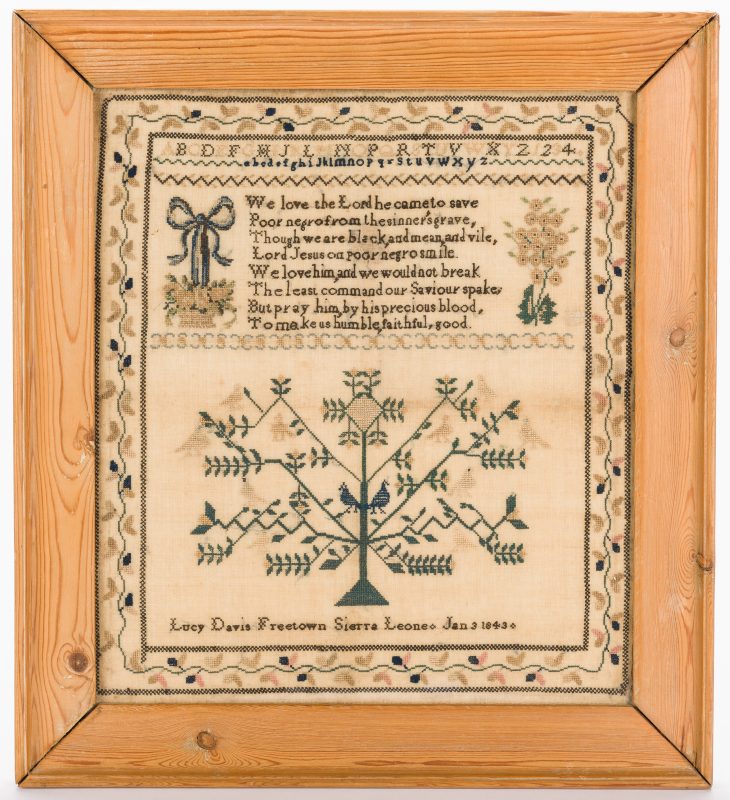 |
|
African Missionary school girl sampler, Freeport, Sierra Leone, with alphabet and phrase by Lucy Davis, dated January 3, 1843. More information in the coming weeks. |
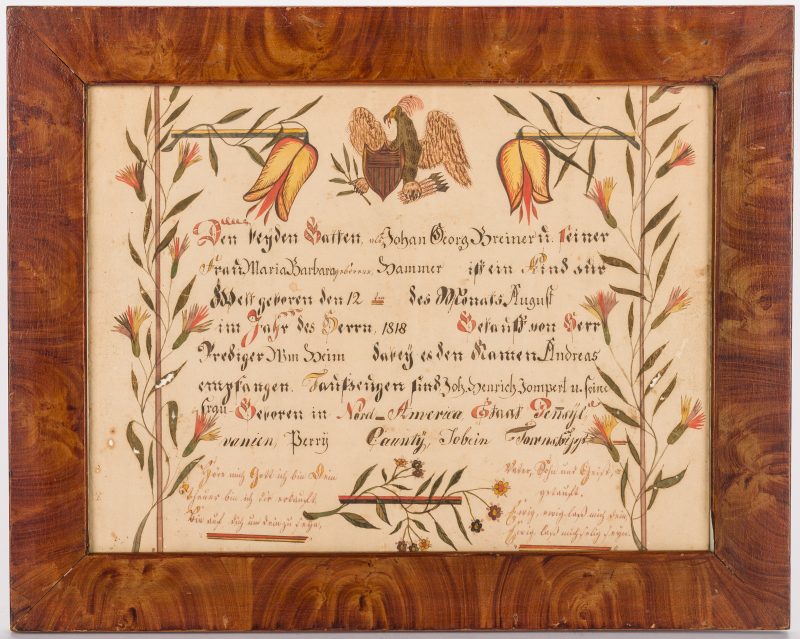 |
|
Pennsylvania German fraktur birth certificate, watercolor and ink on paper, dated 1818, the top center with eagle holding shield, laurel sprig and quiver of arrows, flanked by tall tulip plants. |
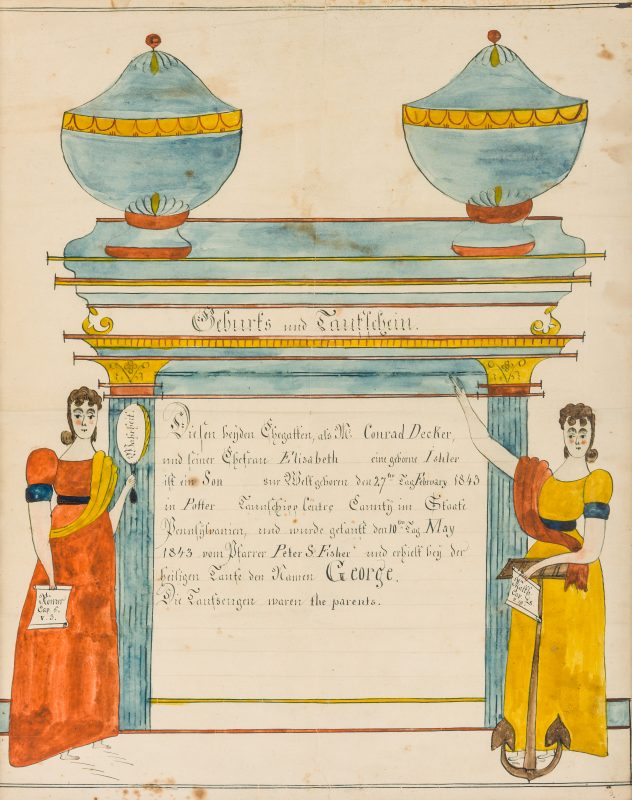 |
|
Rev. Henry Young (American, 1792-1861) Pennsylvania German baptismal and birth announcement fraktur, Geburts und Taufschein, watercolor and ink on paper, Decker family, Centre County, PA, dated 1843. |
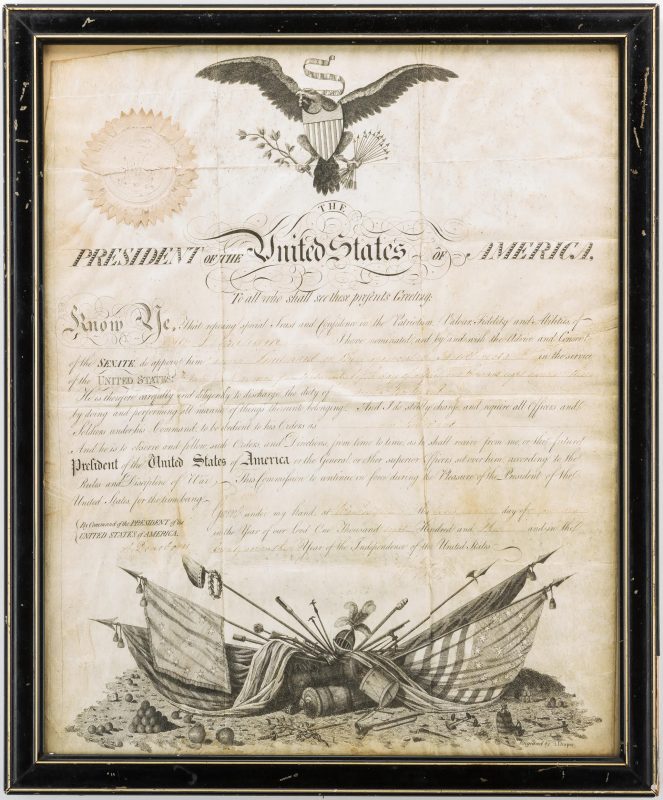 |
|
Military appointment signed by President Thomas Jefferson. More information in the coming weeks. |
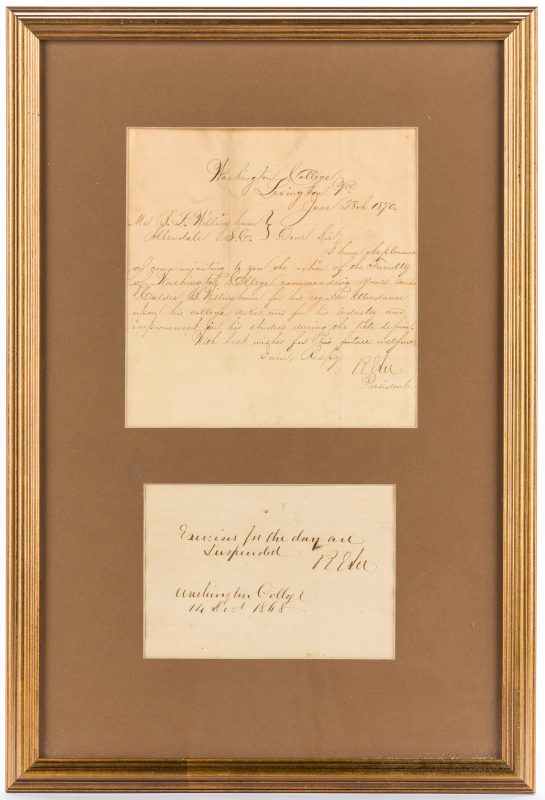 |
|
Two (2) Robert E. Lee (1807-1870) signed letters as President of Washington College, Lexington, VA. 1st item: Signed letter from Lee to Mr. Benjamin L. Willingham, Allendale, S.C., dated June 28, 1870, reading “Dear Sir, I have the pleasure of communicating to you the action of the Faculty of Washington College commending your son Calder B. Willingham for his regular attendance upon his college duties, and for his industry and improvement in his studies during the late se[s]sion. With best wishes for his future welfare, I am, Respy. R E Lee President”. 9 1/8″ H x 7 7/8″ W. 2nd item: Signed memo from Lee, dated December 14, 1868, reading “Exercises for the day are suspended R E Lee Washington College”. 7 1/2″ H x 7 3/4″ W. Obituaries for Elizabeth Martha Baynard Willingham (1830-1887), wife of Benjamin d’Ion Lawton Willingham (1829-1898), dated July 18, 1887, and for her mother Martha Sarah Chaplin Baynard (1805-1889), circa April 23, 1889, together with an article titled “Family Reunion”, circa May 11, 1892, from the “Atlanta Constitution”, attached en verso. Housed under glass in a gilt wood frame. Framed – 20 5/8″ H x 14″ W. Note: The “Family Reunion” article describes Benjamin L. Willingham, Esq. as a man of “splendid physique and commanding appearance, [he] is as polite as a Chesterfield, and active in business as if he has scarcely attained middle life. This remarkable man has reared nine boys, and yesterday all of them dined at their father’s table”. The article states that Calder B. Willingham is “a cotton factor and commission merchant in Macon, Ga., and is known as one of the most benevolent men in the state”. |
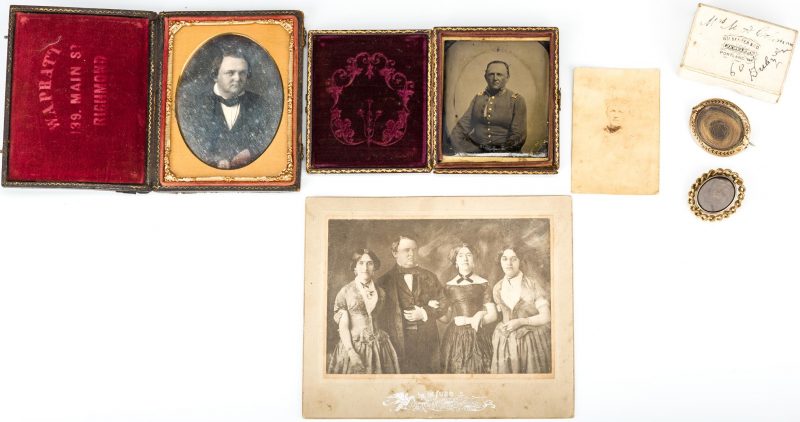 |
|
Civil War photographic and memorial archive of Lewis Minor Coleman. Coleman joined the Confederate army as captain of a Virginia artillery and was later promoted to the rank of lieutenant colonel of artillery in 1862. Coleman was severely wounded at the battle of Fredericksburg, VA December 13, 1862 and died three months later in March, 1863 (Courtesy: Encyclopedia of Virginia Biography, Volume III, By: Lyon Gardiner Tyler, LL. D., Lewis Historical Publishing Company, New York 1915). More information in the coming weeks. |
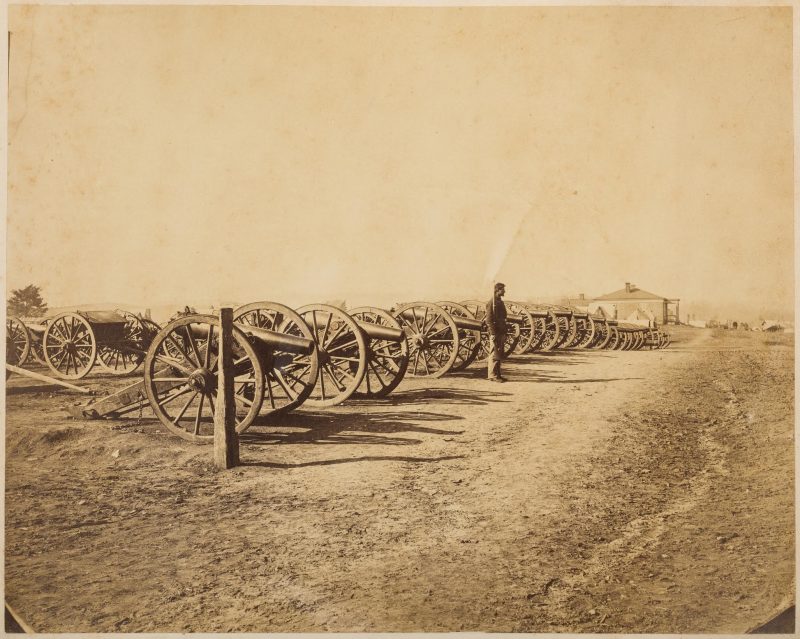 |
|
Large Civil War photograph mounted on card stock depicting Confederate artillery captured at the Battle of Chattanooga, November 1863. Inscriptions lower left margin, “Captured Guns, Mission Ridge Nov 1863” and lower right corner, “Parked opposite General (?illeg – Thomas?) Headquarters in Chattanooga. Pencil inscription verso, upper left corner, “C. H. Boyd” and in crayon “Boyd”. Note: Charles H. Boyd served on General George H. Thomas staff as Captain of the Topographical Engineers, Army of the Cumberland (Source: Civil War Record of Brown University, 1920). Photograph 13 1/4″ x 10 3/4″ card stock 21 1/2″ x 14″. More information in the coming weeks. |
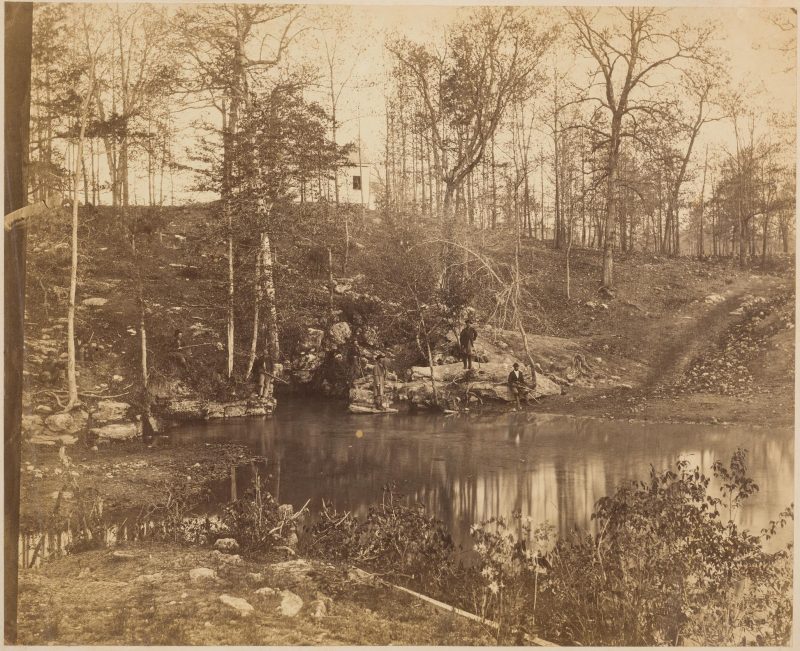 |
|
Large Civil War photograph mounted on card stock titled “Crawfish Springs Chickamauga 1863”. Inscriptions lower left margin, “Picket at Crawfish Spring GA. July 1864 C.H.B.” and lower right corner, “Sharing a Picket Perk”. Pencil inscription verso, upper left corner, “Major Charles H. Boyd” and in crayon “Boyd” and lower left corner, “On the Battlefield of Chickamauga”. Note: Charles H. Boyd served on General George H. Thomas staff as Captain of the Topographical Engineers, Army of the Cumberland (Source: Civil War Record of Brown University, 1920). Photograph 13 3/4″ x 11″ card stock 22″ x 14 1/2″. Additional note – Crawfish Springs was the last source of water for many Union soldiers prior to the Battle of Chickamauga. The entire campaign was marked by a water shortage due to a drought in the summer of 1863 (ref: National Park Service).
|
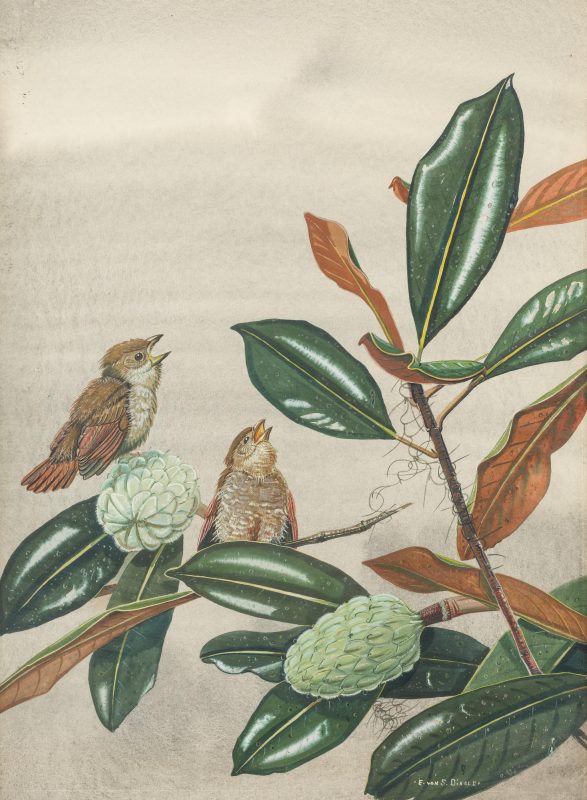 |
|
Edward Von Siebold Dingle (South Carolina , 1893-1975) watercolor and gouache on paperboard painting of two immature cardinals perched on Magnolia branches. Signed lower right and numbered in pencil #767. Title or possible exhibition label affixed en verso and also numbered #57; Whatman stamped label en verso. Giltwood and composition frame. 22″ x 15″ unframed, 27 1/2″ x 21 1/2″ frame. Biography: Edward Von Siebold Dingle grew up on a Charleston, South Carolina plantation. His mother was a noted bird artist and helped guide his career combining orinthology and art; he also studied with Alfred Hutty. His primary medium was watercolor. Like John James Audubon, Dingle painted from specimens he collected, and his collection of more than a thousand bird skins is now housed in the Charleston museum. Dingle’s work was exhibited in the first American exhibition of bird paintings, held in Los Angeles in 1926. His works also were exhibited at the American Museum of Natural History in New York, at the Mint Museum in Charlotte, North Carolina, and in Canada. |
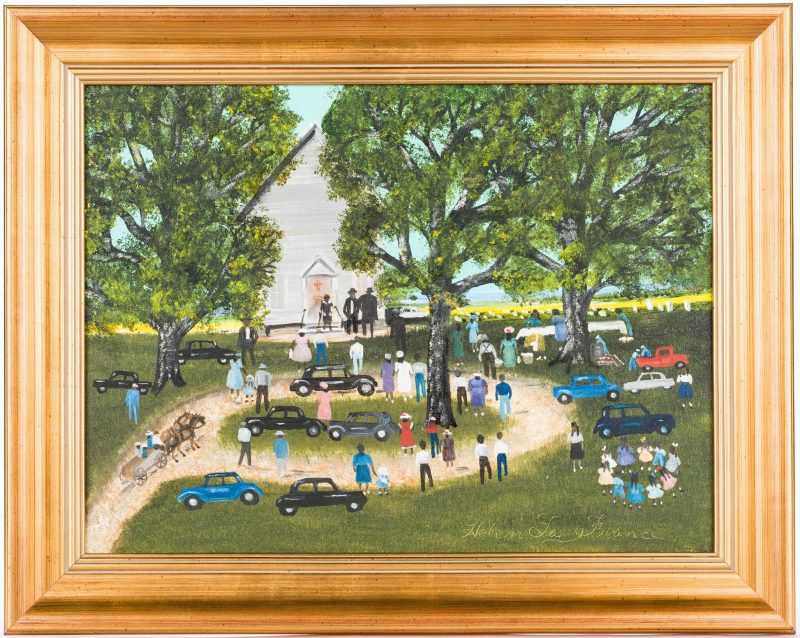 |
|
Helen LaFrance (Kentucky, b. 1919), oil on canvas painting depicting a Church Picnic, with automobiles parked in front of a church and horse and buggy approaching lower left; a table is being spread in the right middle ground while a group of girls plays a circle game in the right foreground. Signed lower right. Housed in a giltwood molded frame. Sight 17 1/2″ x 23 1/2″, framed 23″ x 29″. |
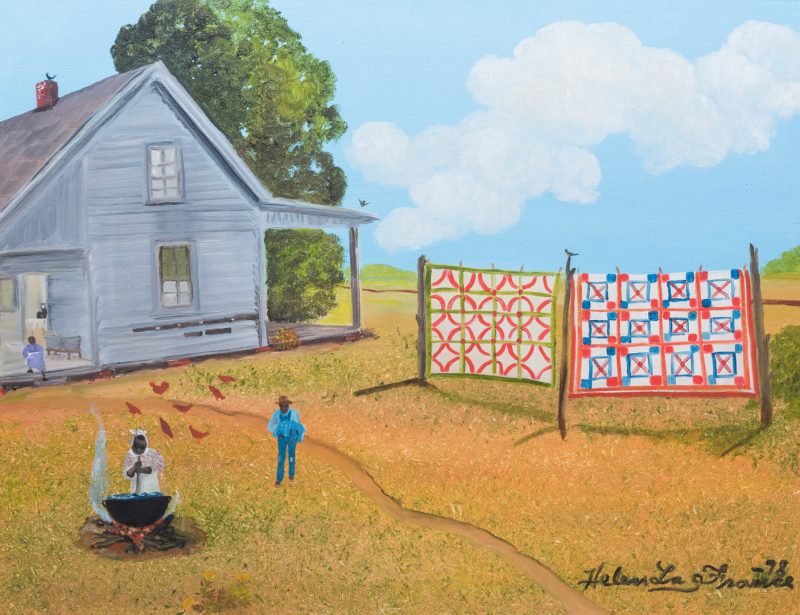 |
|
Helen LaFrance (Kentucky, born 1919) oil on canvas painting titled “Laundry Day” depicting two quilts on a clothes line and a woman stiring the contents of a large kettle. Signed and dated “78”, lower right. Exhibition label with title and medium and label with alternate title “On the Farm”, en verso. Housed in a contemporary wooden frame. Sight – 21 1/2″ H x 27 1/2″ W. Framed – 24 3/4″ H x 30 3/4″ W. One of several Helen LaFrance paintings to be offered in this auction. |
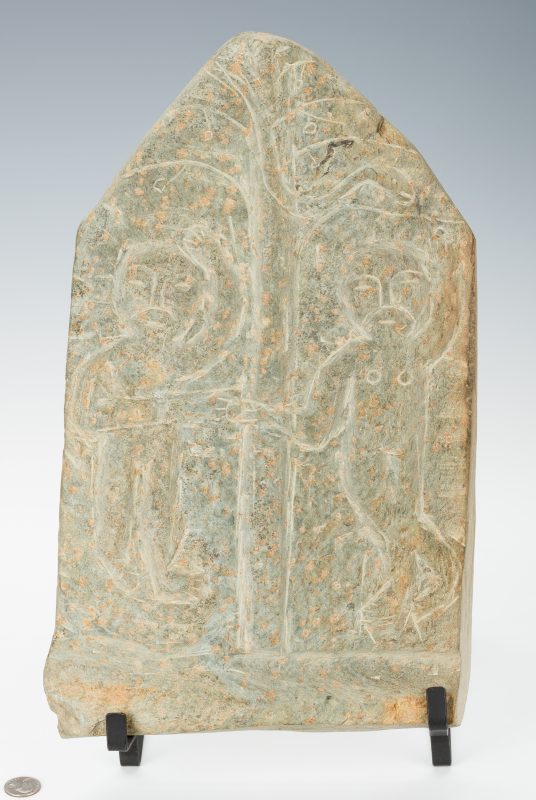 |
|
Raymond Coins (American/North Carolina, 1904-1998) carved river stone stele or plaque depicting Adam and Eve in the garden of Eden, with a serpent coiled around a tree. Inscribed signature en verso. 18″ H x 10 1/4″ W x 1″D. |
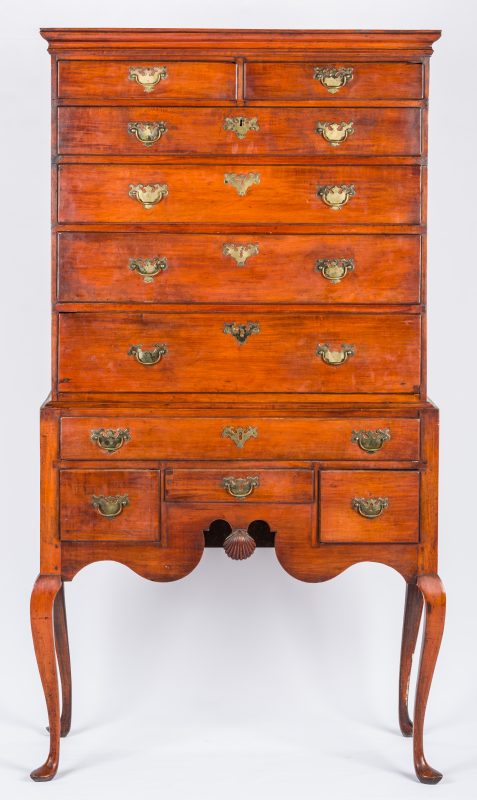 |
|
18th century New England Queen Anne two piece highboy, cherry primary, poplar secondary. Flat overhanging molded top and molded cornice. Upper section with five tiers of graduated drawers, top tier with two narrow drawers, all with brass batwing pulls. Lower section with full length drawer over three smaller drawers, scalloped skirt with central carved shell and cabriole legs terminating in slipper feet. More information in the coming weeks… |
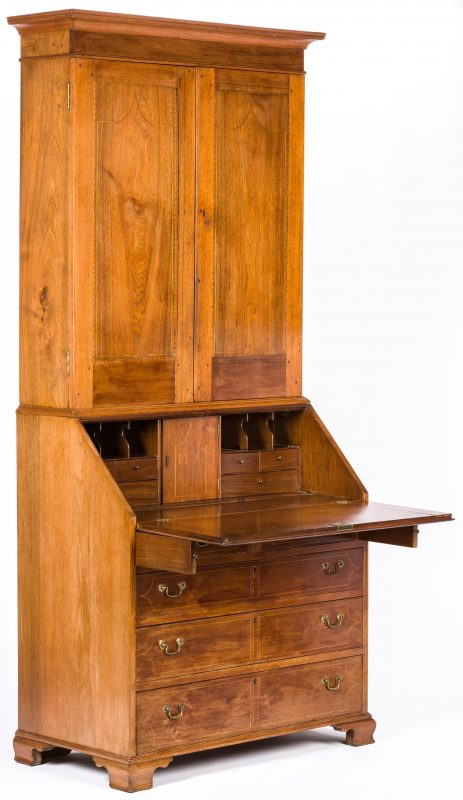 |
|
Middle Tennessee, possibly Wilson County, inlaid desk and bookcase, walnut primary, poplar secondary, in two sections. Upper section with a cove molded cornice over inlaid cupboard doors with barber pole and geometric string inlay enclosing shelves; the lower section with an inlaid slant lid with battened ends and inlay including barber pole, string and the initials N. G. , falling forward onto two pull out slides. Interior fitted with six (6) shaped pigeonholes over two (2) tiers of dovetailed drawers and central inlaid door with the initials N. G. within a cartouche, all over four (4) tiers of string and barber pole inlaid graduated dovetailed drawers with brass pulls, molded base and ogee feet. 91″ H x 39″ W x 22 1/4″D. 1st Qtr. 19th century. Two similar desk examples are featured in the book “The Art and Mystery of Tennessee Furniture and It’s Makers Through 1850” by Nathan Harsh and Derita Williams that are attributed to James or Captain John B. Quarles, figures 63 and 64 on pages 104 and 105. The ogee feet, cornice, and mid-molding on this example appear to be late 19th/early 20th century replacements. |
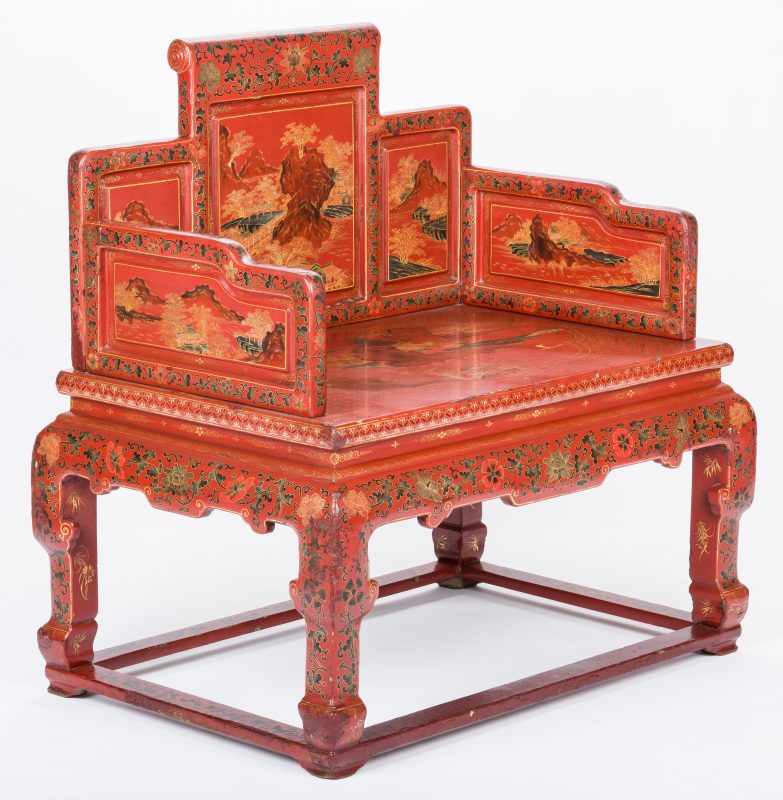 |
|
Chinese red lacquer and gilt throne chair, Qing Dynasty. Provenance: A Nashville, Tennessee estate – more information in the coming weeks. |
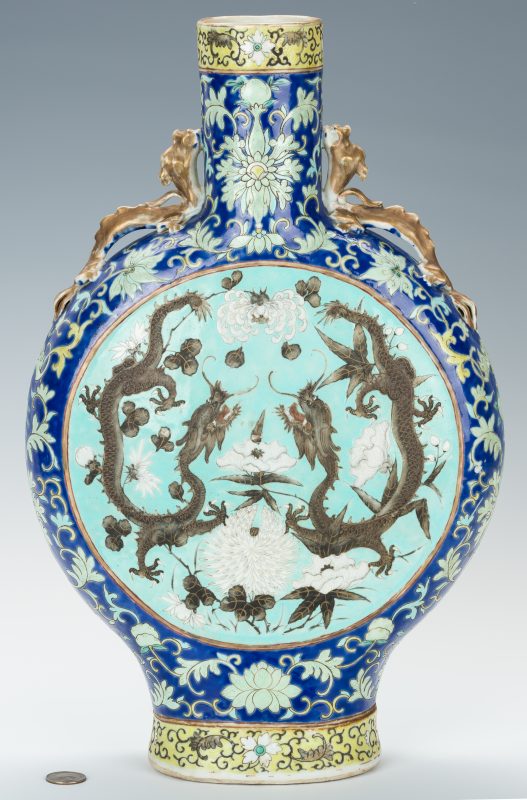 |
|
Chinese Famille Rose porcelain moon flask, circular form with cylindrical neck, footed base and Chi Dragon form handles. Center body with enamel painted opposing dragon and floral decoration on a teal ground. Sides and neck with bat, peach and foliate enamel paint decoration on a dark blue ground. Rim and footed base with yellow floral band decoration. 17 3/4″ H x 11 1/2″ dia. Late 19th century. |
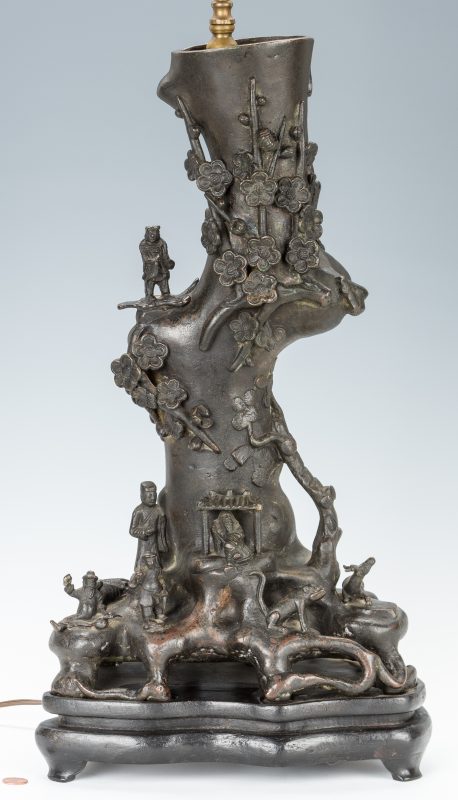 |
|
Large Asian bronze sculpture depicting a large tree trunk with figures of men engaged in various activities amongst the branches along with a foo dog figure, an ox figure, a deer figure, and dogwood blossoms entwined around the trunk, all on a raised and pierced naturalistic root base. Now mounted as a lamp and fixed to a conforming ebonized base. Vase measures 18 3/4″ H. 29 1/2″ total H x 11 1/2″ W x 9 1/2″ D. Late 19th century. Provenance: A Nashville, Tennessee estate. |
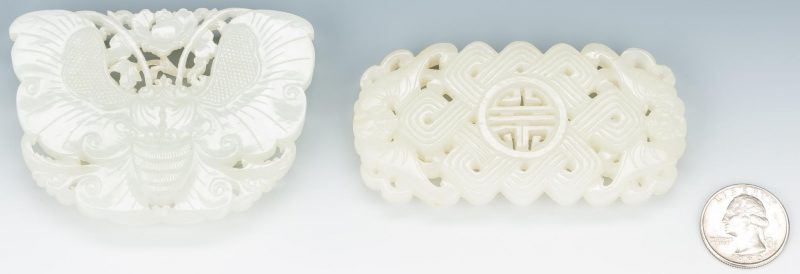 |
|
1st item: Chinese carved and pierced white/pale celadon belt ornament, carved in the form of a butterfly with carved flower head hooks. 2 1/2″ H x 3 1/4″ W. 2nd item: Chinese carved and pierced white/pale celadon belt ornament, rectangular form with central good luck symbol on a woven ground and bats to each side. 1 3/4″ H x 3 1/2″ W. Both Late 19th/Early 20th century. Provenance: Private West Tennessee collection. |
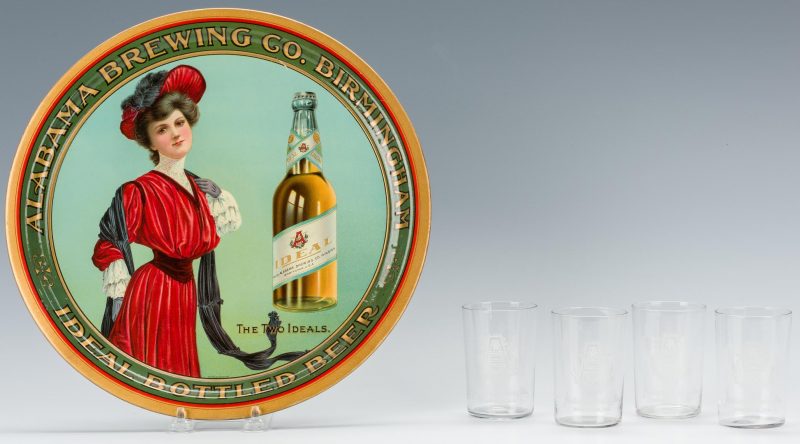 |
|
Alabama Brewing Brewing Company, Birmingham, Alabama pre-prohibition lithographic tin advertising beer tray. Center depicting a young female in red with a bottle of beer with the caption THE TWO IDEALS. Rim reading ALABAMA BREWING CO. BIRMINGHAM/IDEAL BOTTLED BEER. Tray printed by Kaufmann & Strauss Company, New York. Together with four (4) etched Alabama Brewing Company beer glasses. Etched decoration including the company trademark logo. Tray measures – 13″ dia. Glasses measure – 3 3/8″ H. |
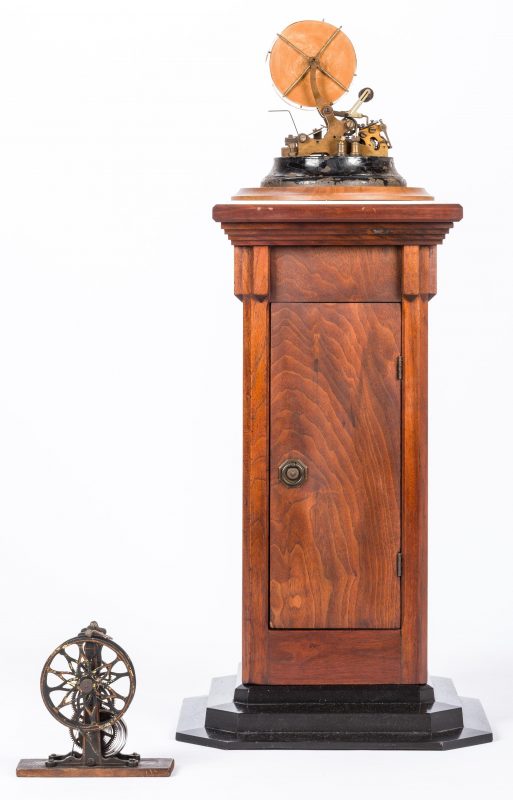 |
|
Western Union Model 2825 3-A 22 OHMS universal ticker tape machine, serial # 2495, with brass frame, telegraph mechanism, twin alpha-numeric rollers and tape feed, all housed in a cast iron base with Western Union label reading: Western Union Telegraph Co. Manufacturer name not present. Includes glass dome with marble top Western Union cabinet stand, internal mechanisms housed in a light green metal rectangular box. a paper winder, and a roll of used ticker paper. Machine – 10″ H x 9″ W. Glass dome – 12 1/4″ H. Stand – 31″ H x 18 1/4″ W. Overall – 44″ H. Late 19th/early 20th century. |
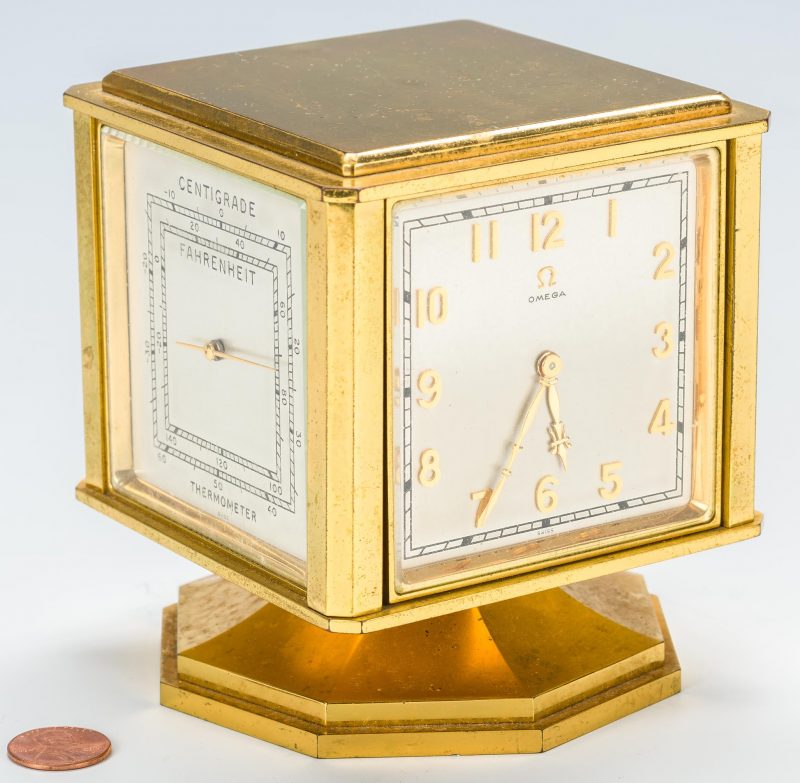 |
|
Omega Bienne desk weather station, comprised of a clock, hygrometer, barometer, and thermometer in Fahrenheit and Centigrade, all housed in a gold plated bronze case on an octagonal swivel base. Four dials, eight-day gong and keyless. Back of the barometer marked “Zenith/42079/8MCH”. 4 1/2″ H. Circa 1950. |
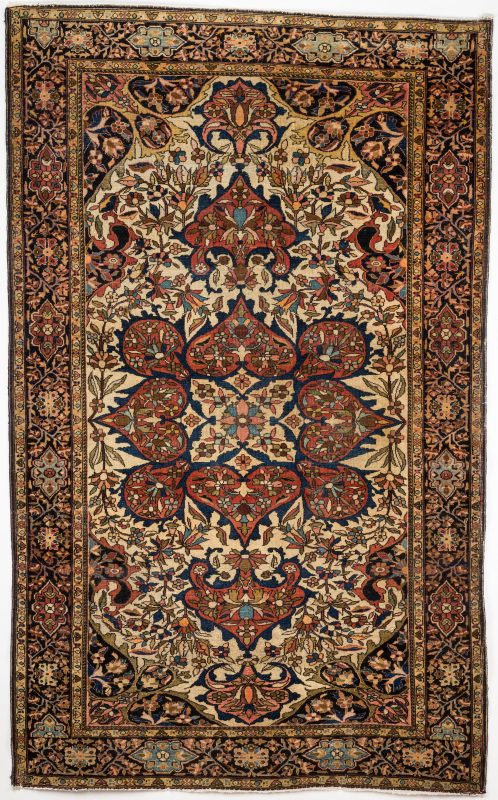 |
|
Antique Fereghan Sarouk area rug, 6’6″ x 4′ 1″, wool on cotton, center medallion, cream field, dark blue major border, secondary colors of dark blue, red, ivory, gold, navy, medium blue, pink, salmon, green and brown, circa 1900. |











































































